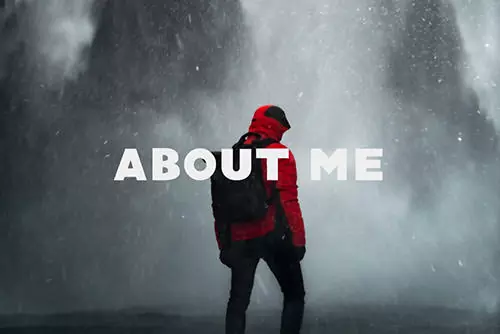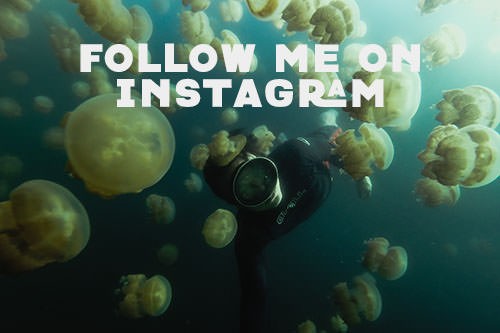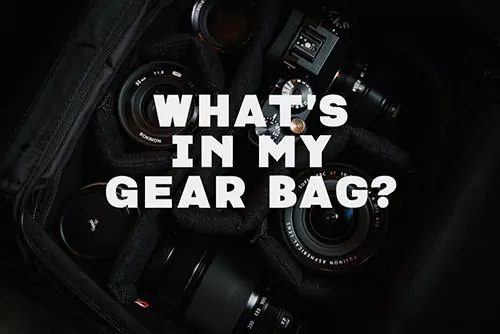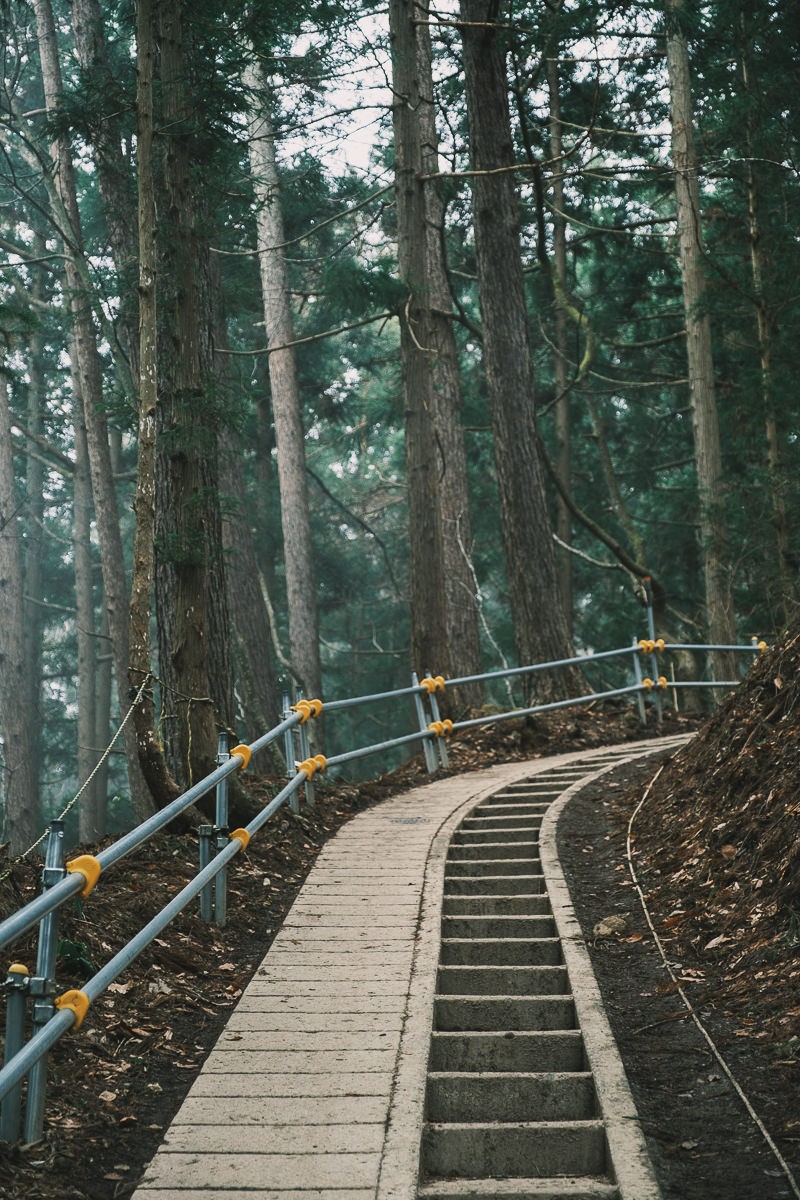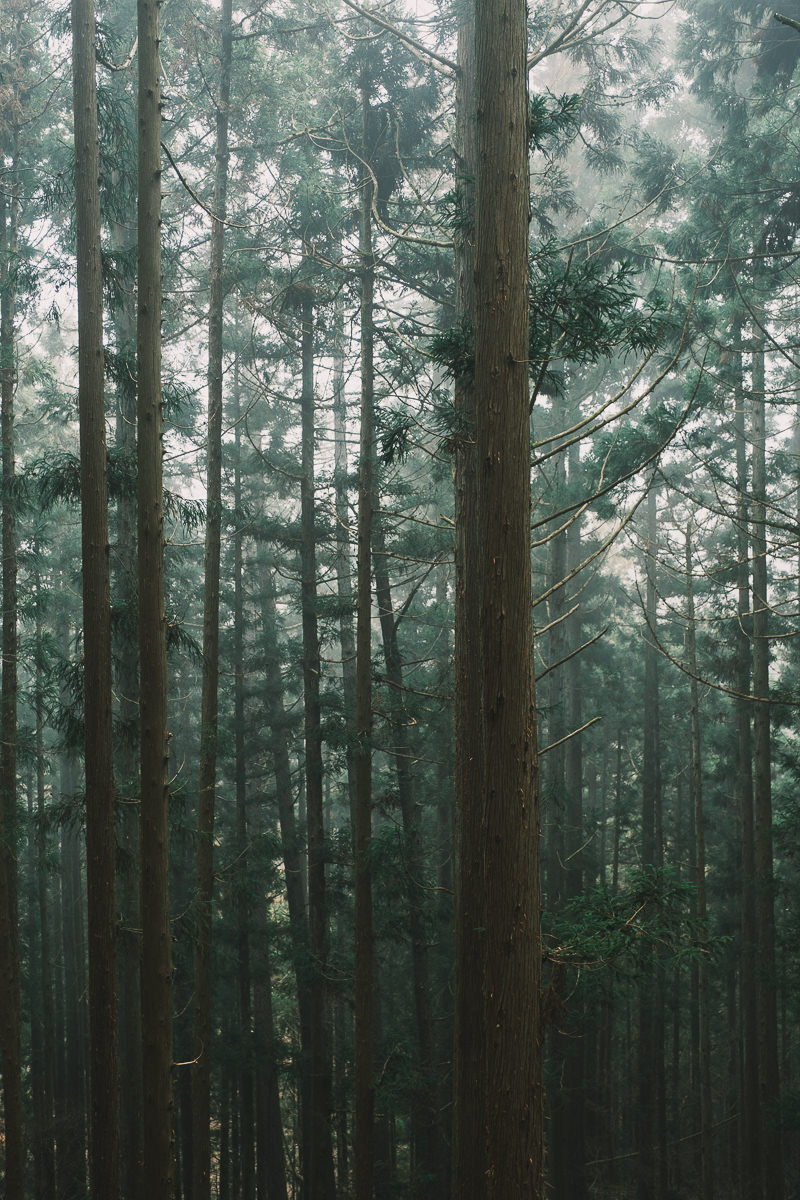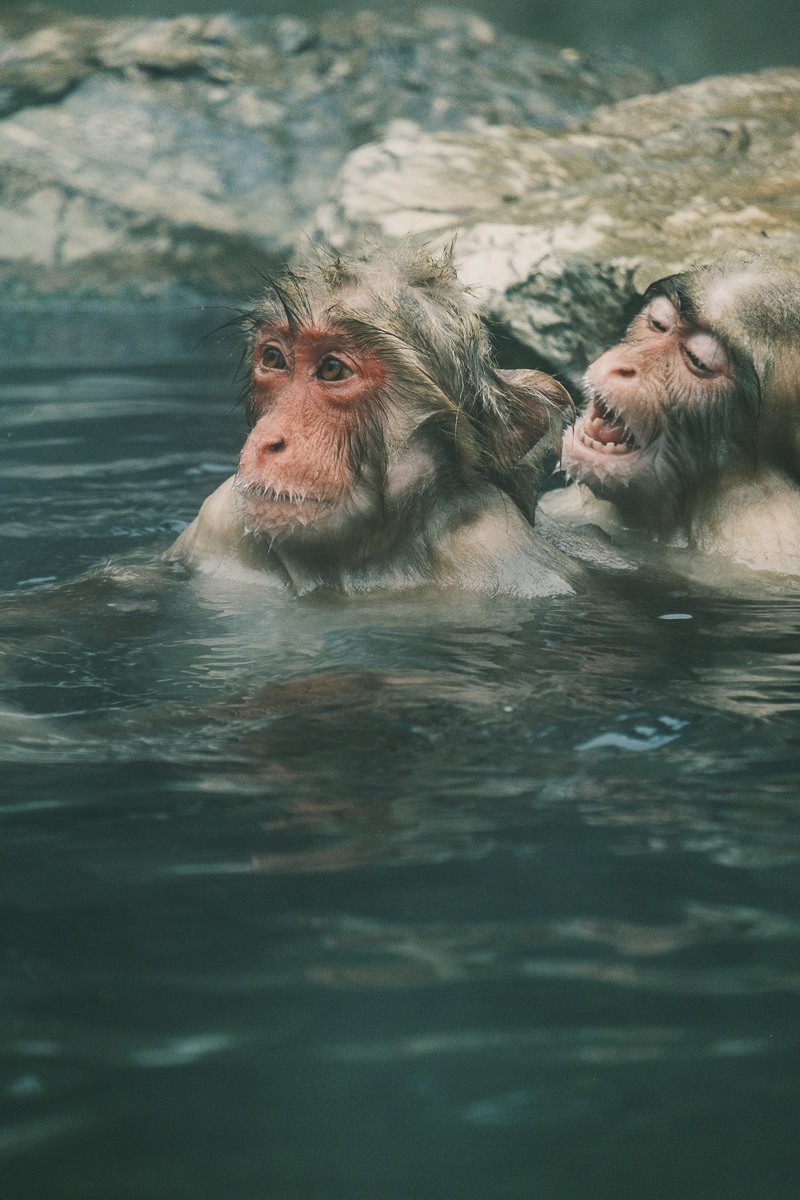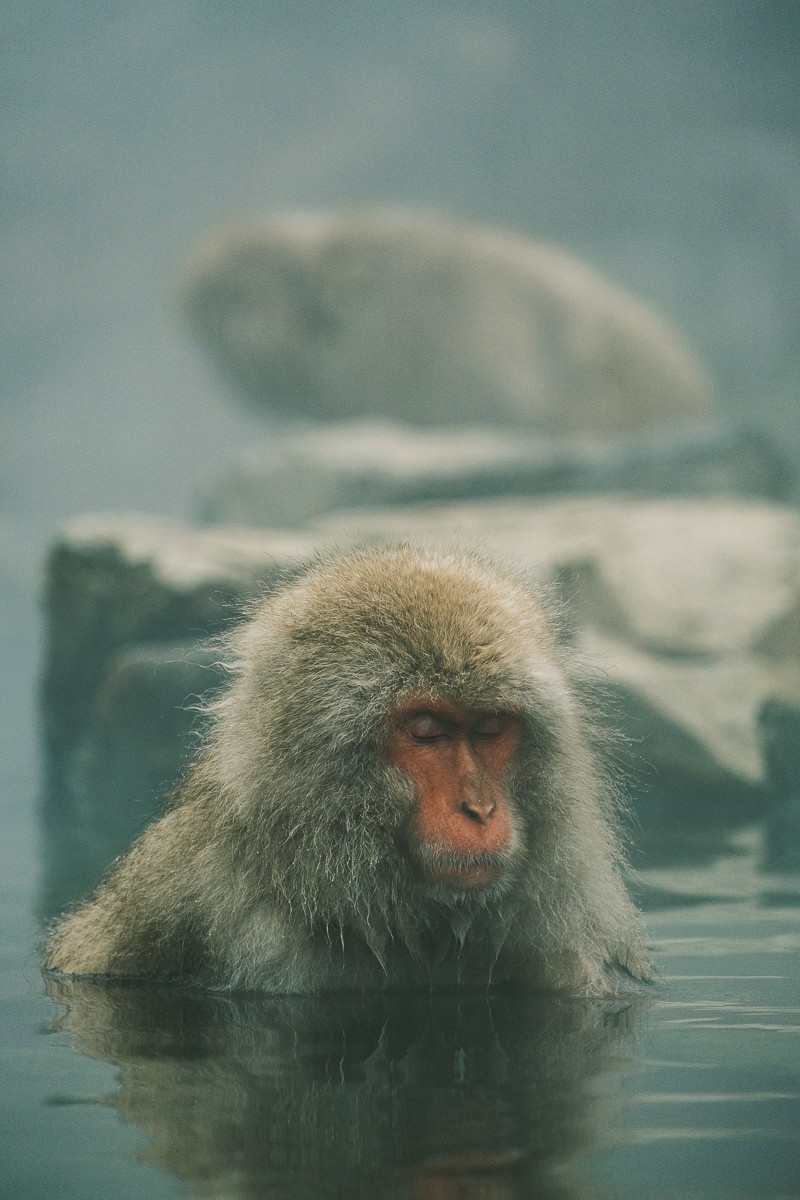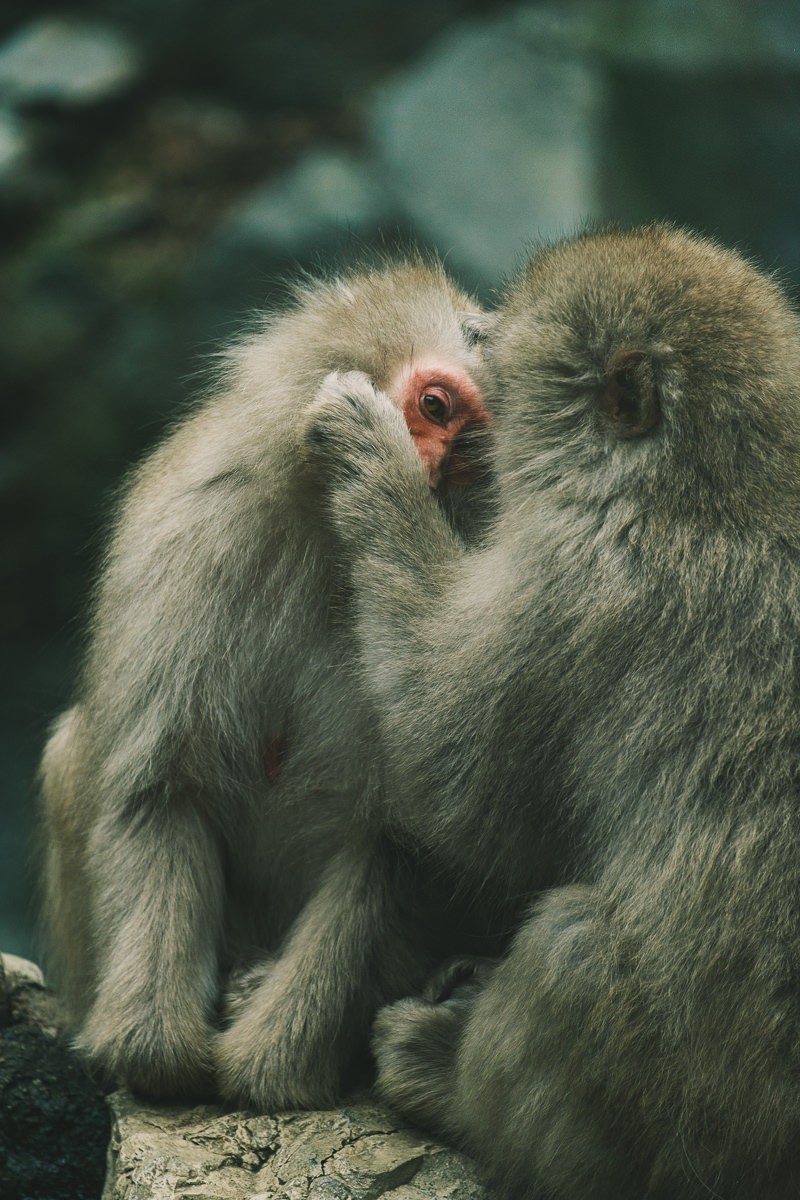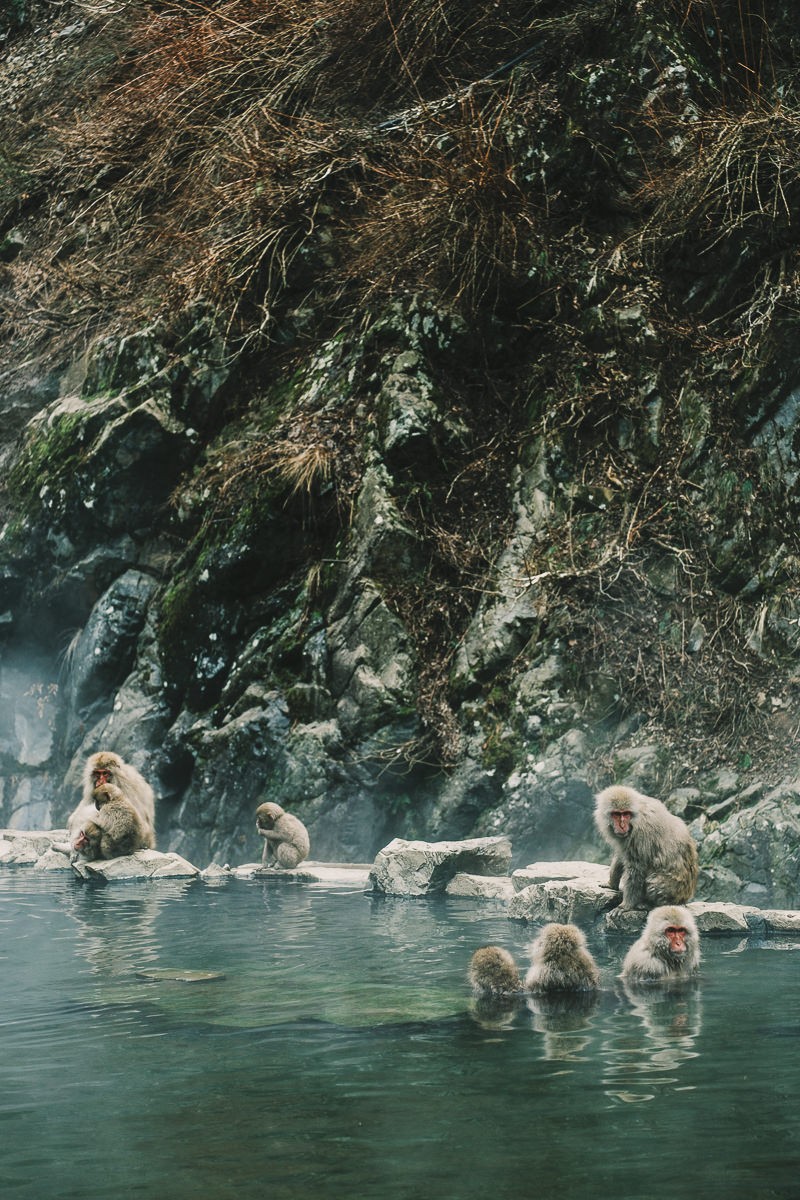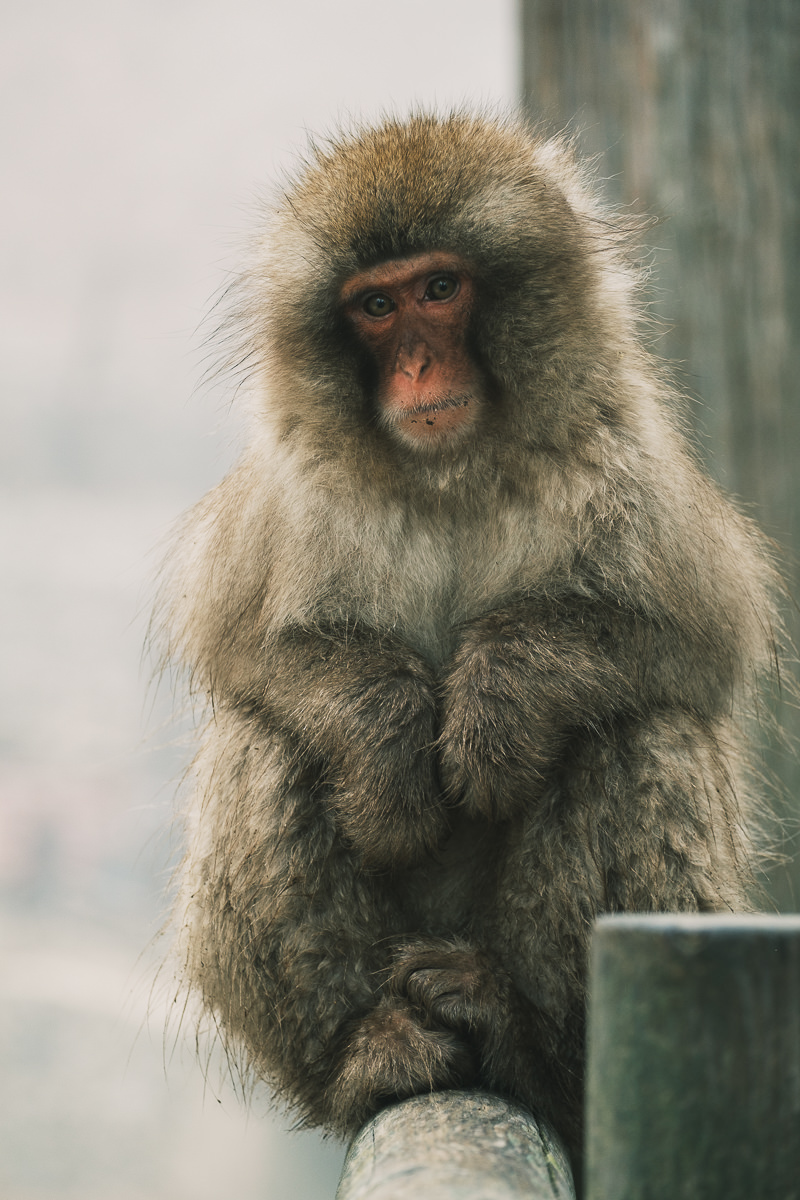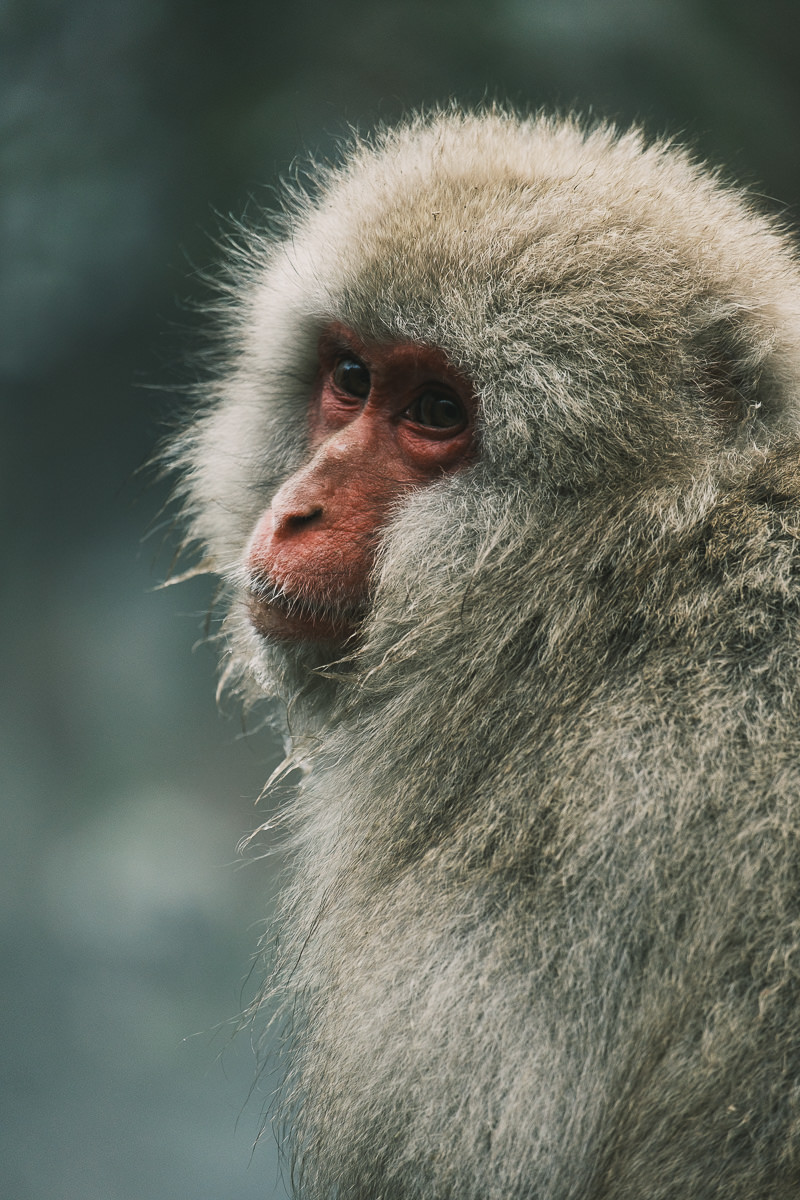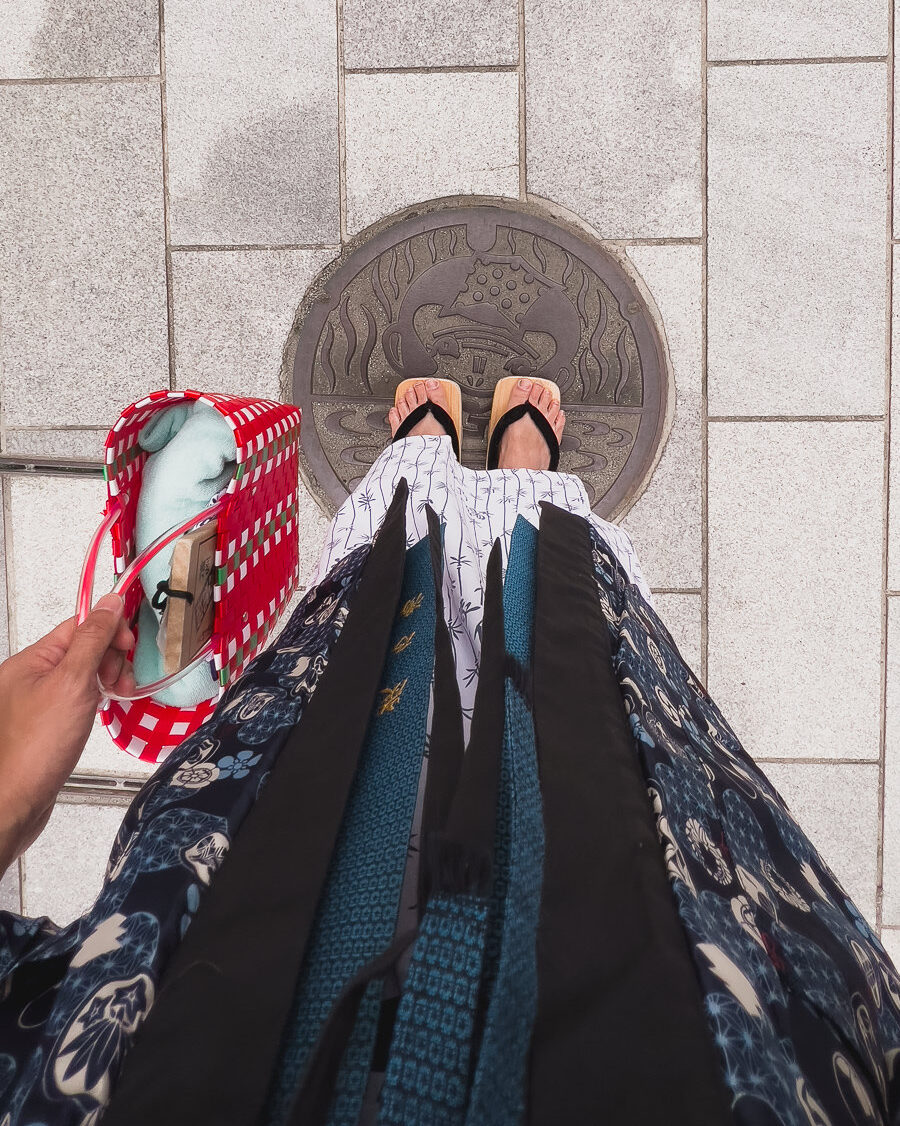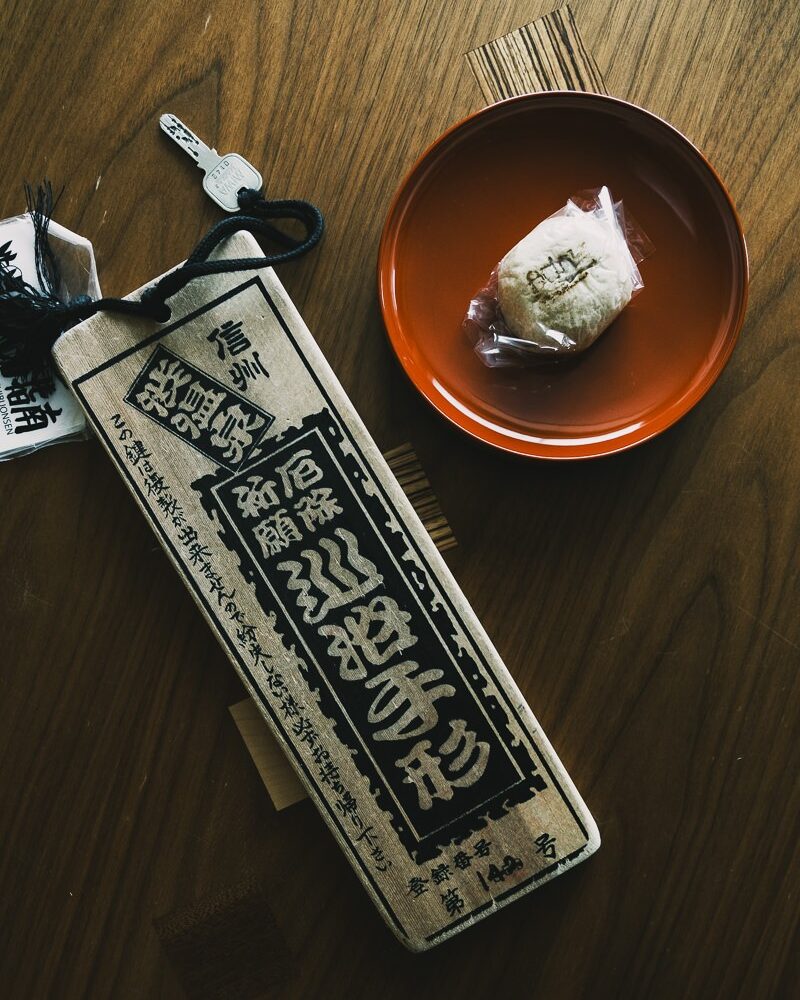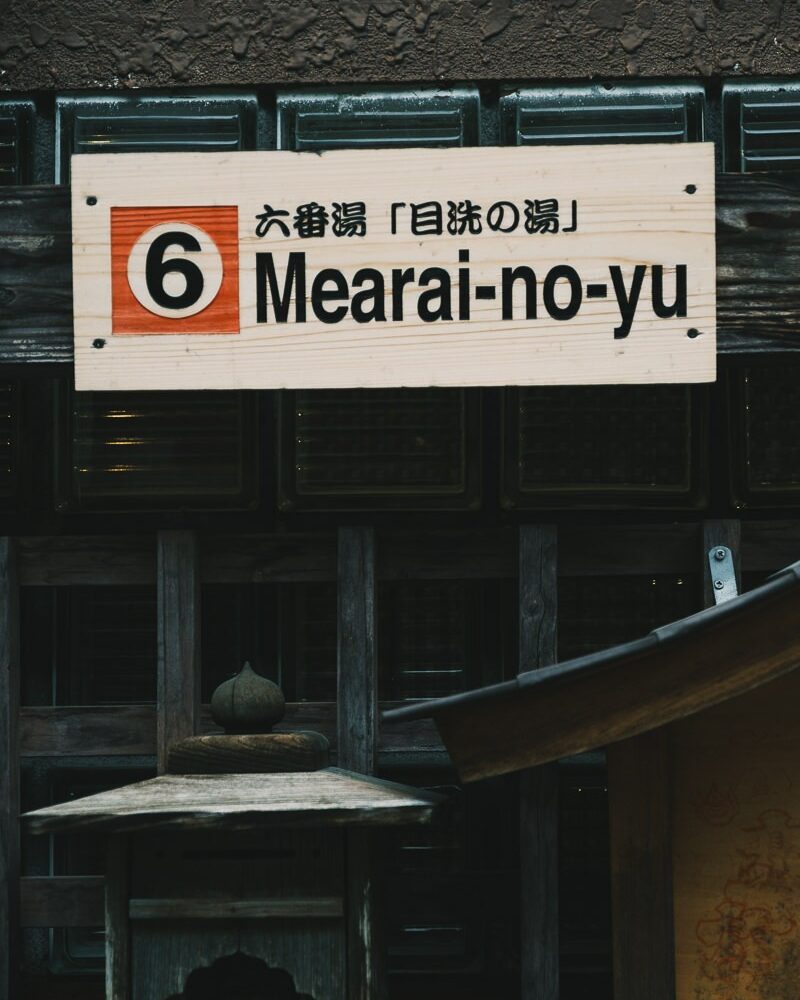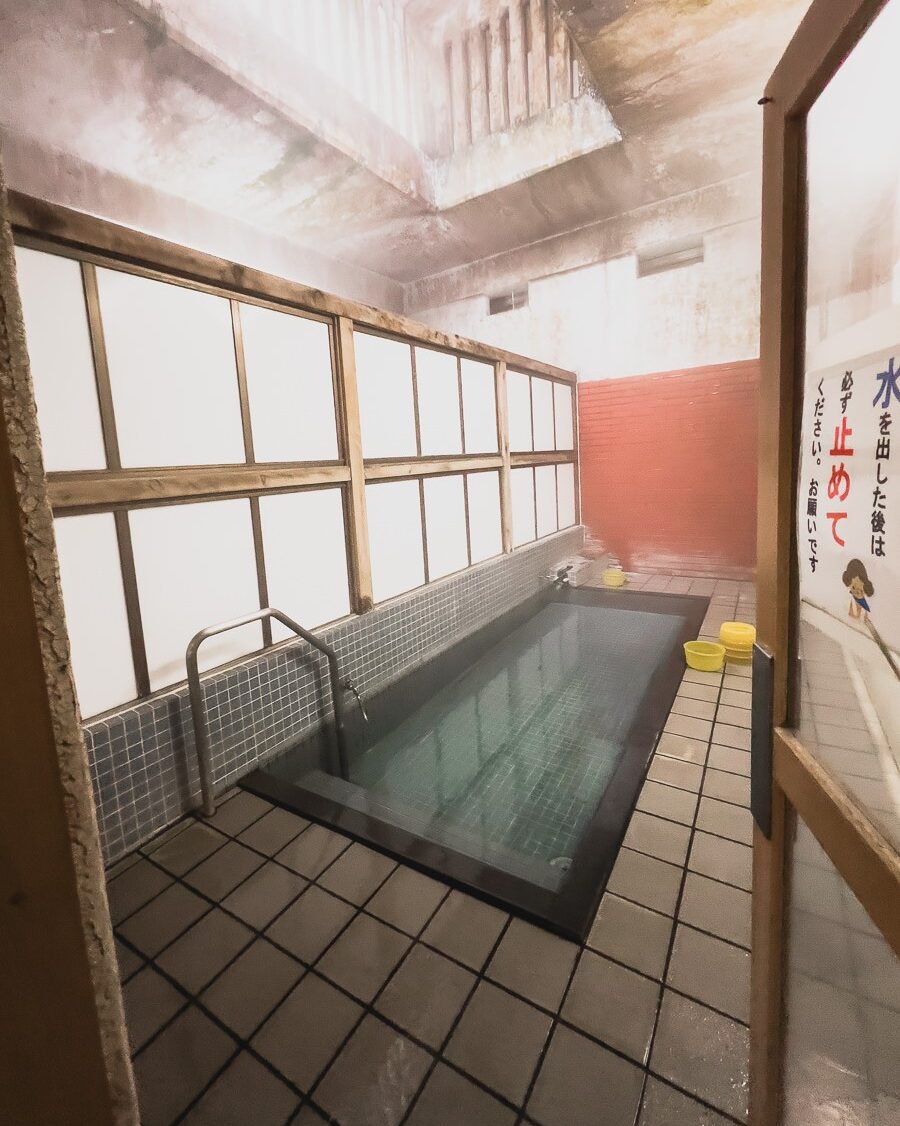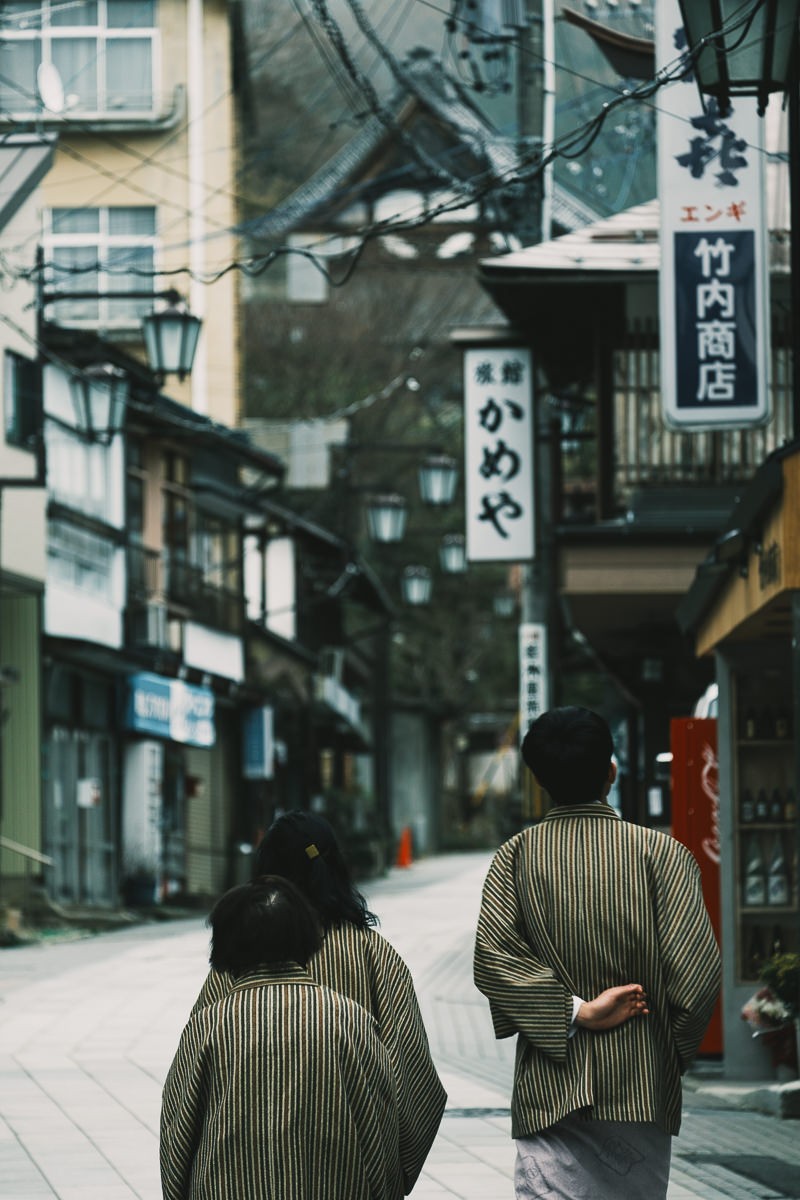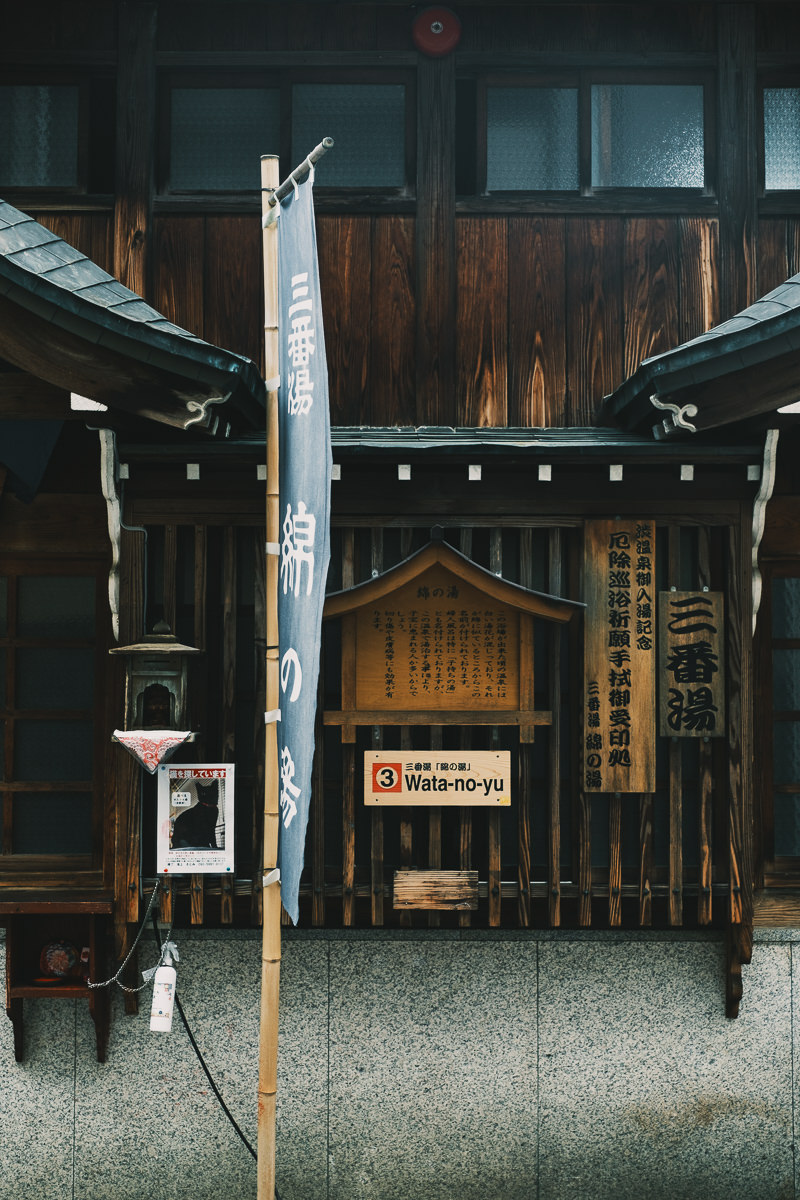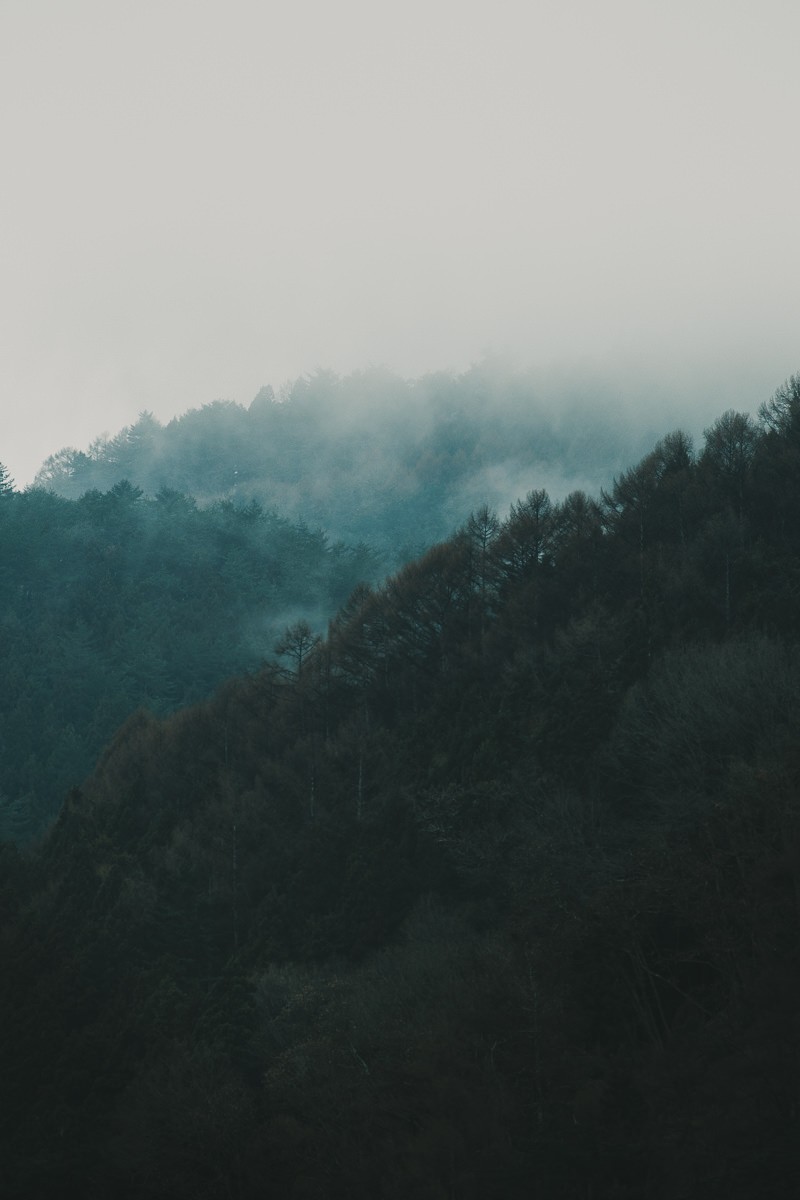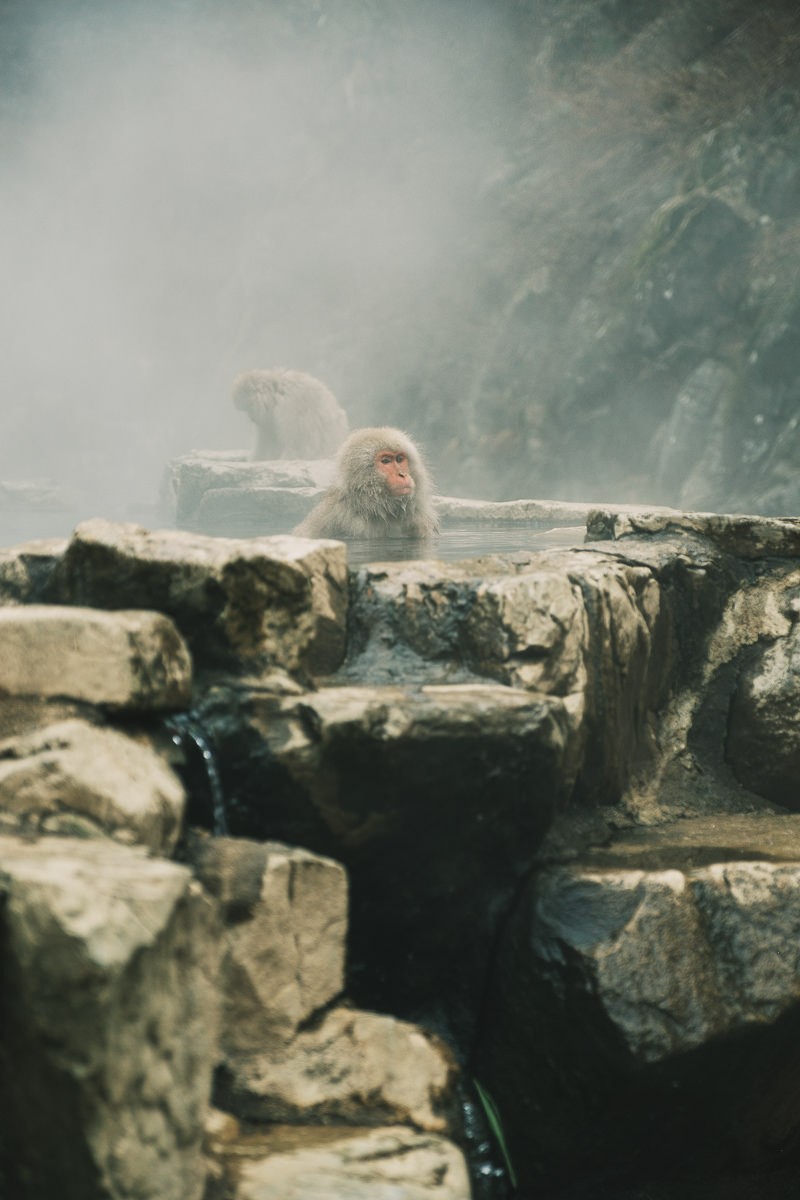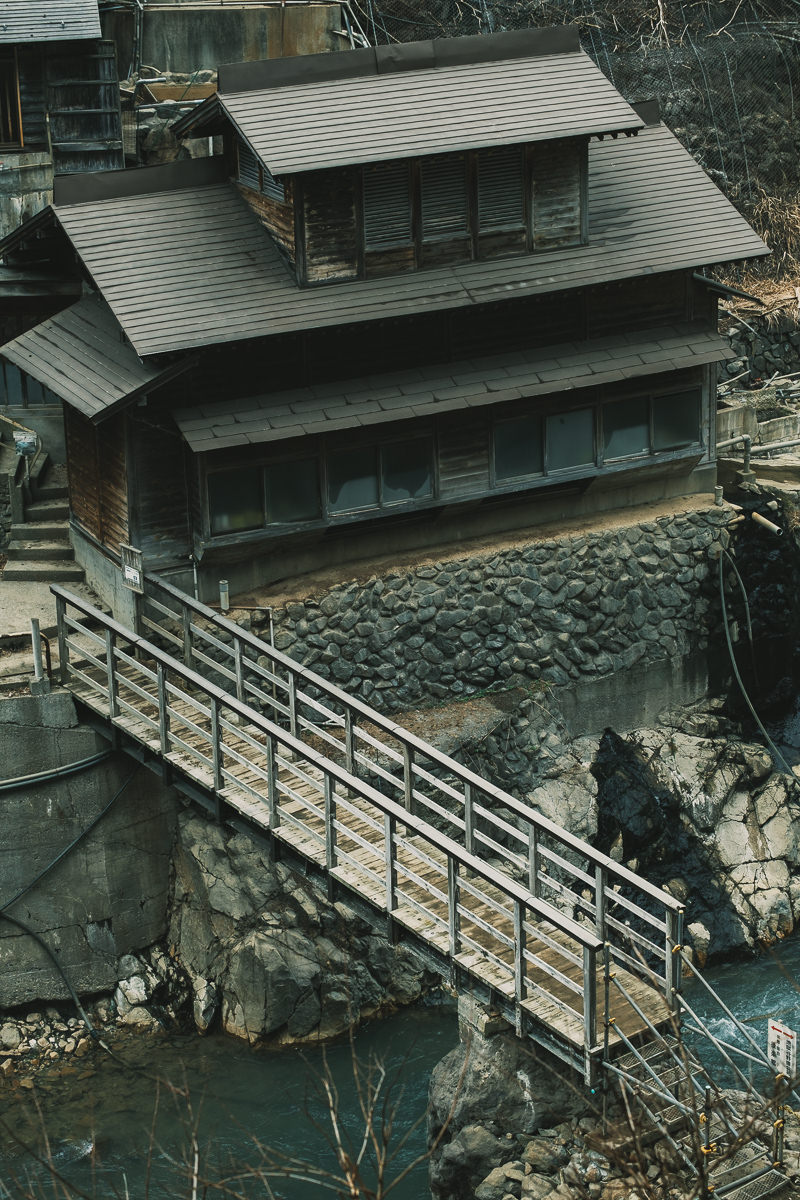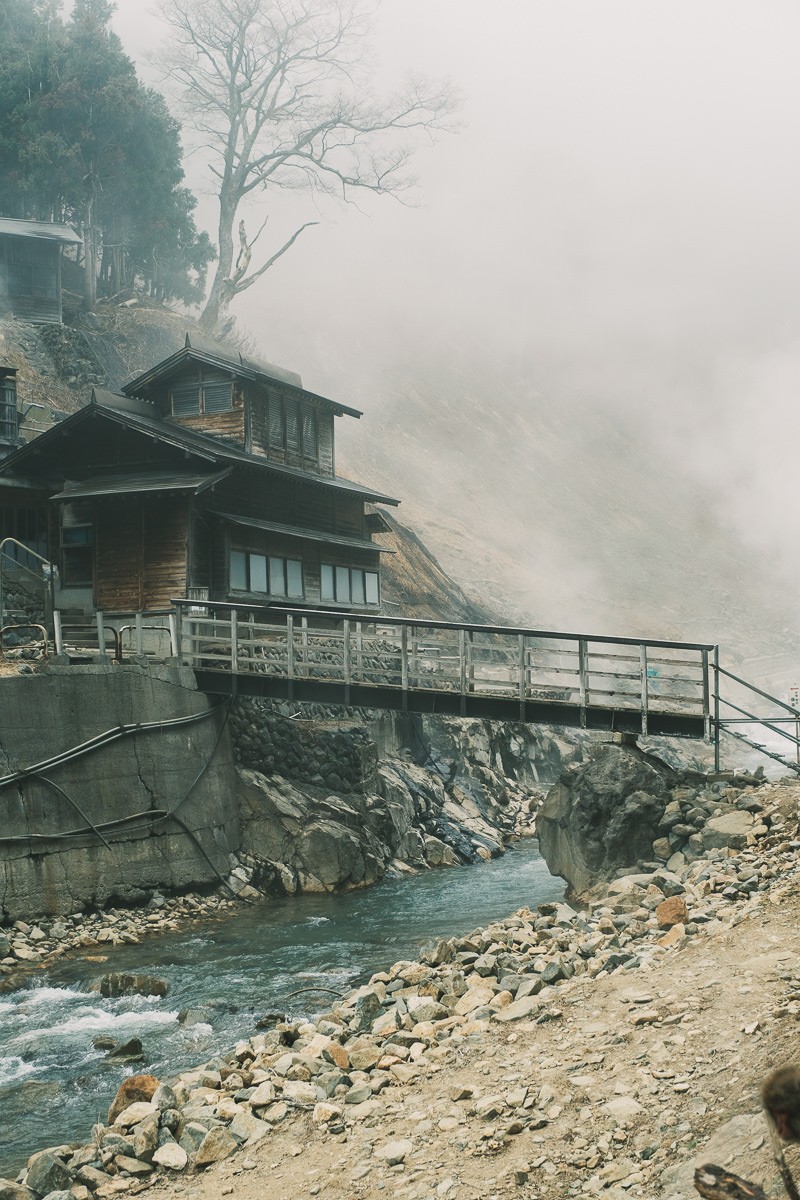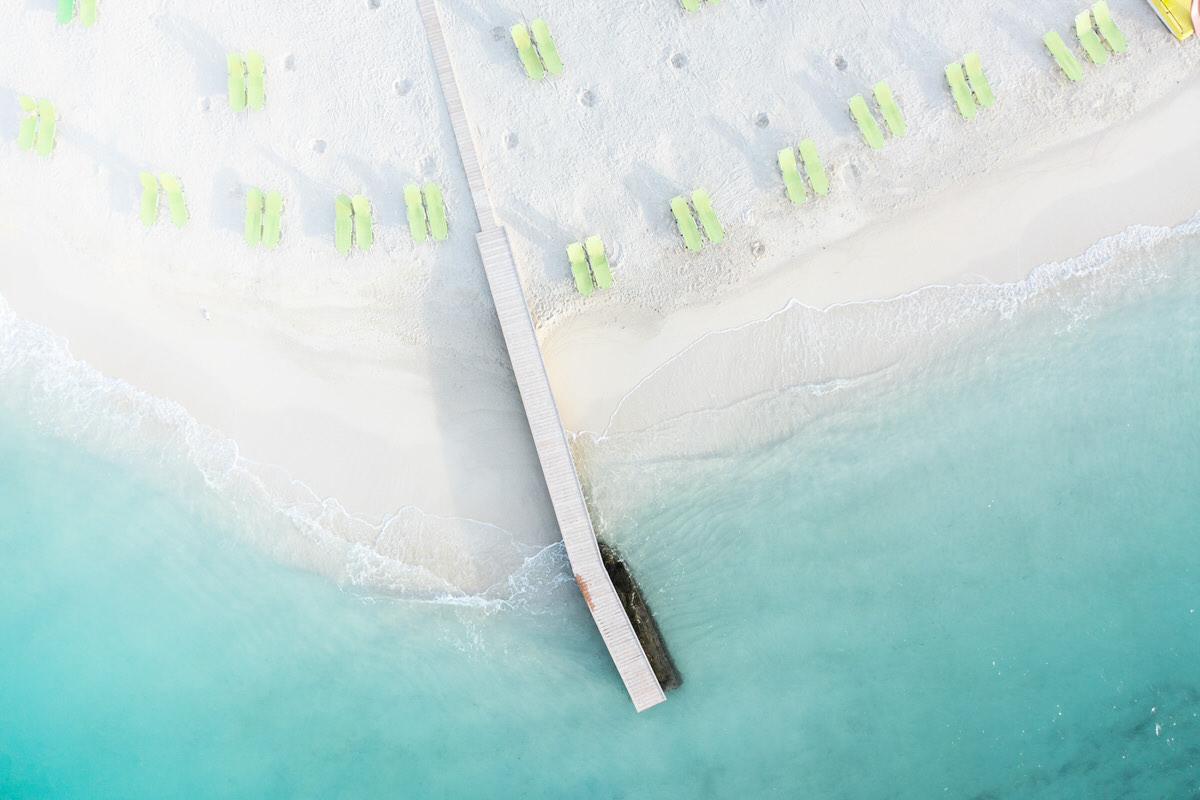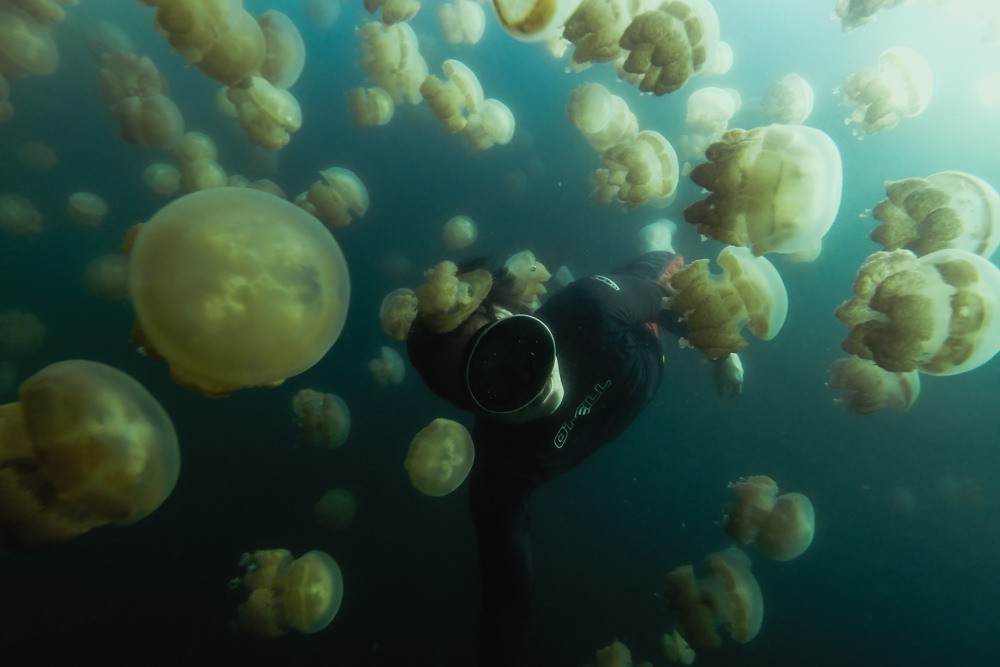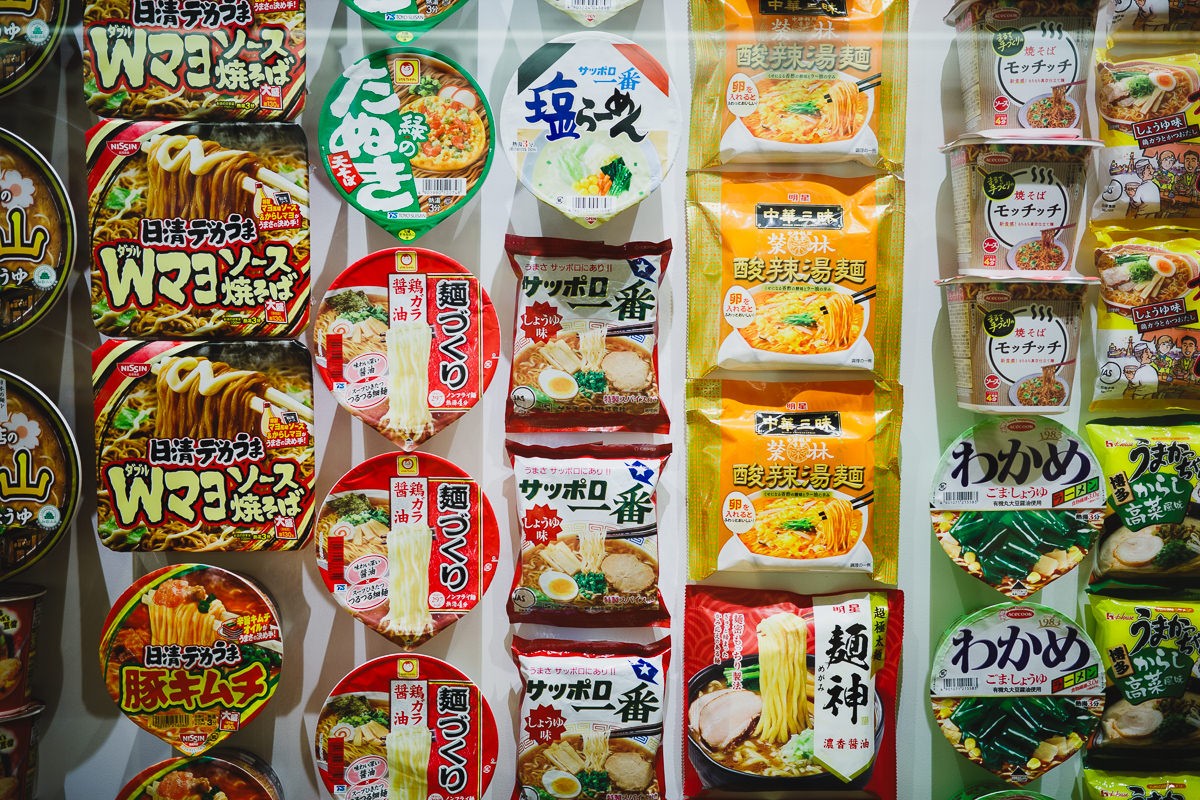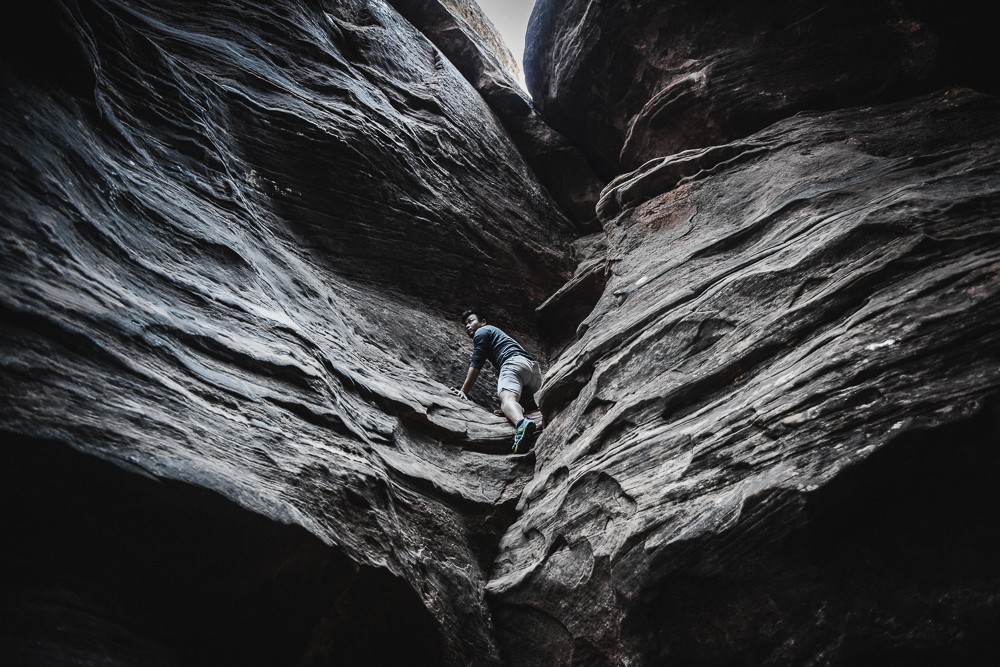Japanese Snow Monkeys: A Complete Guide To Visiting Jigokudani Monkey Park
Japanese Snow Monkeys: A Complete Guide To Visiting Jigokudani Monkey Park
You’ve probably seen the photograph – a fluffy money sitting eyes closed, its wet coat of fur, thick and plush, is clumped and frosted at the tips in snow. Half of its body is submerged in water. You can feel the wind chill in the air from the blur of steady snowflakes falling and landing gently on the surface of the water before disappearing. The monkey must be cold, but it looks relaxed and meditative, and the warm steam rising from the hot spring pool eases your concern.
When I learned about the ‘snow monkeys’ in Japan, bathing in a natural onsen (Japanese for hot spring), I immediately added it to my winter bucket list.
A few years later, I made the most of my JR Rail Pass and planned a stop at Nagano before returning to Tokyo. From Nagano, I transferred by local train to Yudanaka and booked into beautiful ryokans in the famed hot spring town of Shibu Onsen. This would be my home base for two days of bathing, exploring the town’s nine famous bathhouses – and to finally see the wild Japanese macaque ‘snow monkeys’ bathing for myself. The place is called Jigokudani Yaen Koen aka the Jigokudani Monkey Park and this is the best place to see the monkeys bathing.
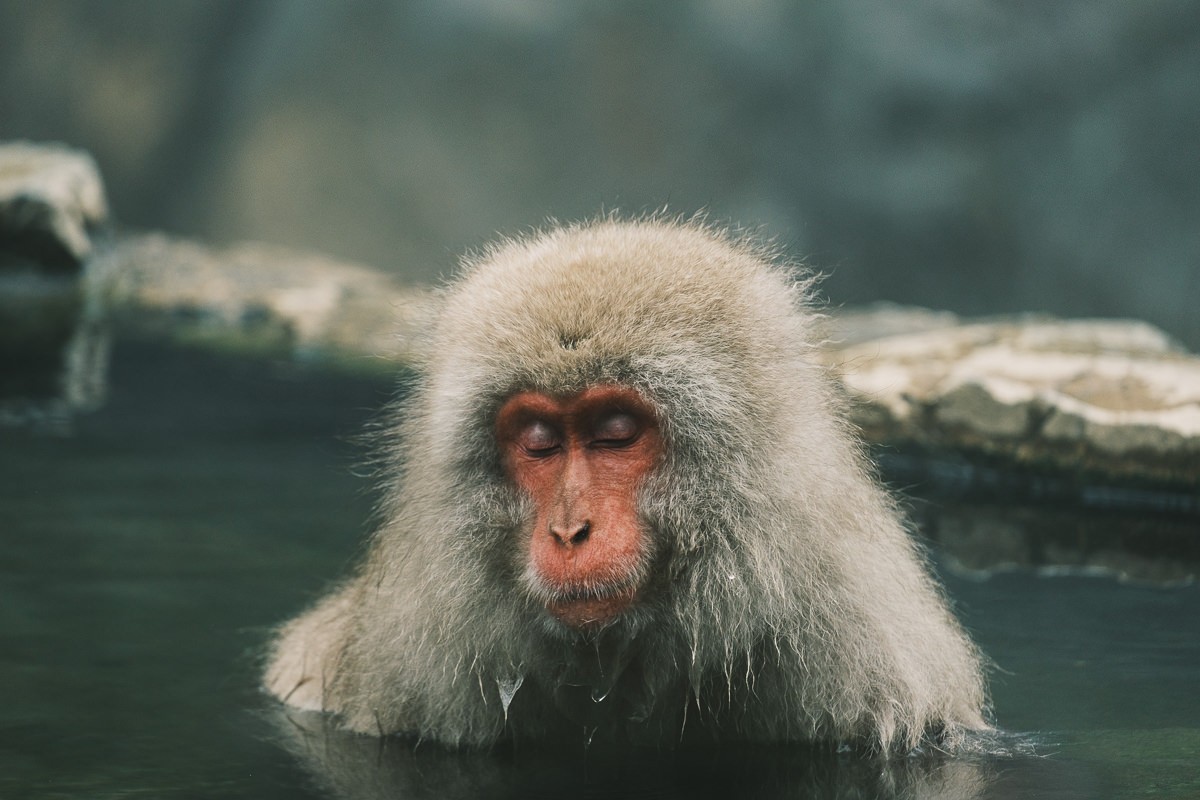
The Real History Of The Snow Monkeys
In the late 1950s, a local hiker and nature lover named Sogo Hara noticed that the displaced macaques from the nearby mountains started raiding the nearby farms. Their troublesome behavior left the farmers no choice, but to hunt them. In an effort to protect the monkeys, Hara and the owner of the Korakukan ryokan began luring the monkeys away from the farm towards the inn in Jigokudani Valley.
There, the local story goes, some apples fell into the outdoor hot spring pool and one of the monkeys went in after it. He must have enjoyed the warm water, because he stayed. Monkey see, monkey do, and the other monkeys began testing the waters for themselves. The pair had inadvertently observed and discovered a way to keep the monkeys safe – by feeding them apples and barley and allowing them to bathe in the hot springs. The first photograph of the monkeys bathing was taken by Tomio Yamada in 1962, attracting broader interested from the scientific community in this unprecedented behavior.
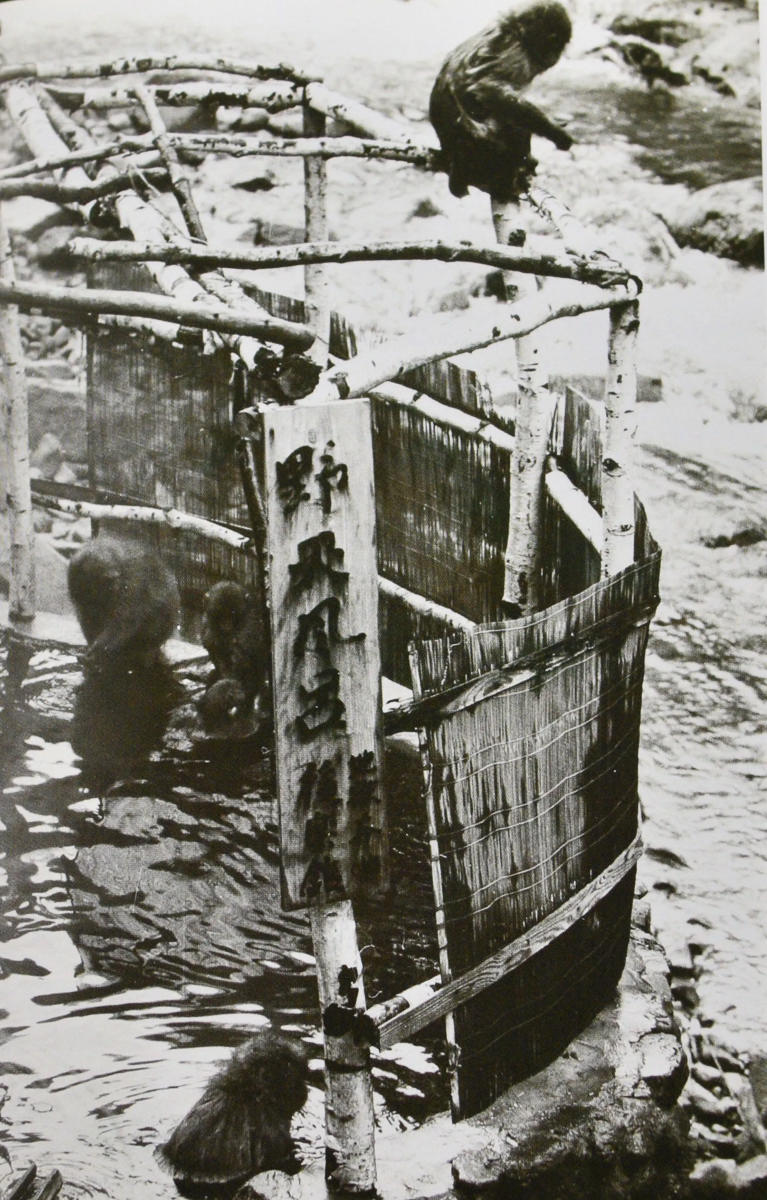
The Opening Of Jigokudani Monkey Park
Since the bath was still used by guests of the ryokan, for hygienic reasons, a separate bathing area was needed for the monkeys. The ensuing collective efforts of the many invested parties led to the construction of the Jigokudani Monkey Park in 1964, just across the river from the Korakukan ryokan. They built a separate bathing hot spring for the monkeys at the park and started feeding them here.
Year after the year, the monkeys returned, especially during the cold winter months to enjoy the warm waters.
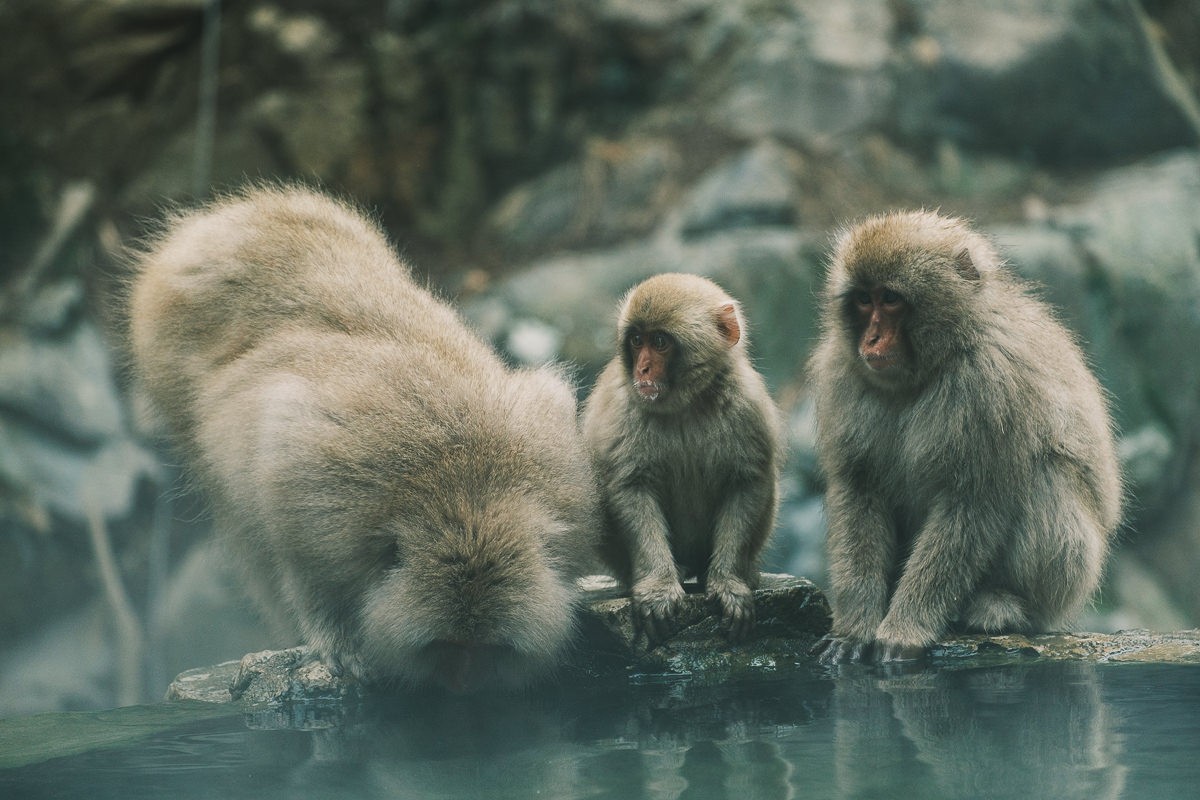
Making The Cover Of Life Magazine
The snow monkeys international fame they made the cover of LIFE magazine on January 30, 1970. The photographs, taken by renowned wildlife photographer Kojo Tanaka, captured the serene and almost human-like expressions of the monkeys, much to the delight of readers worldwide.
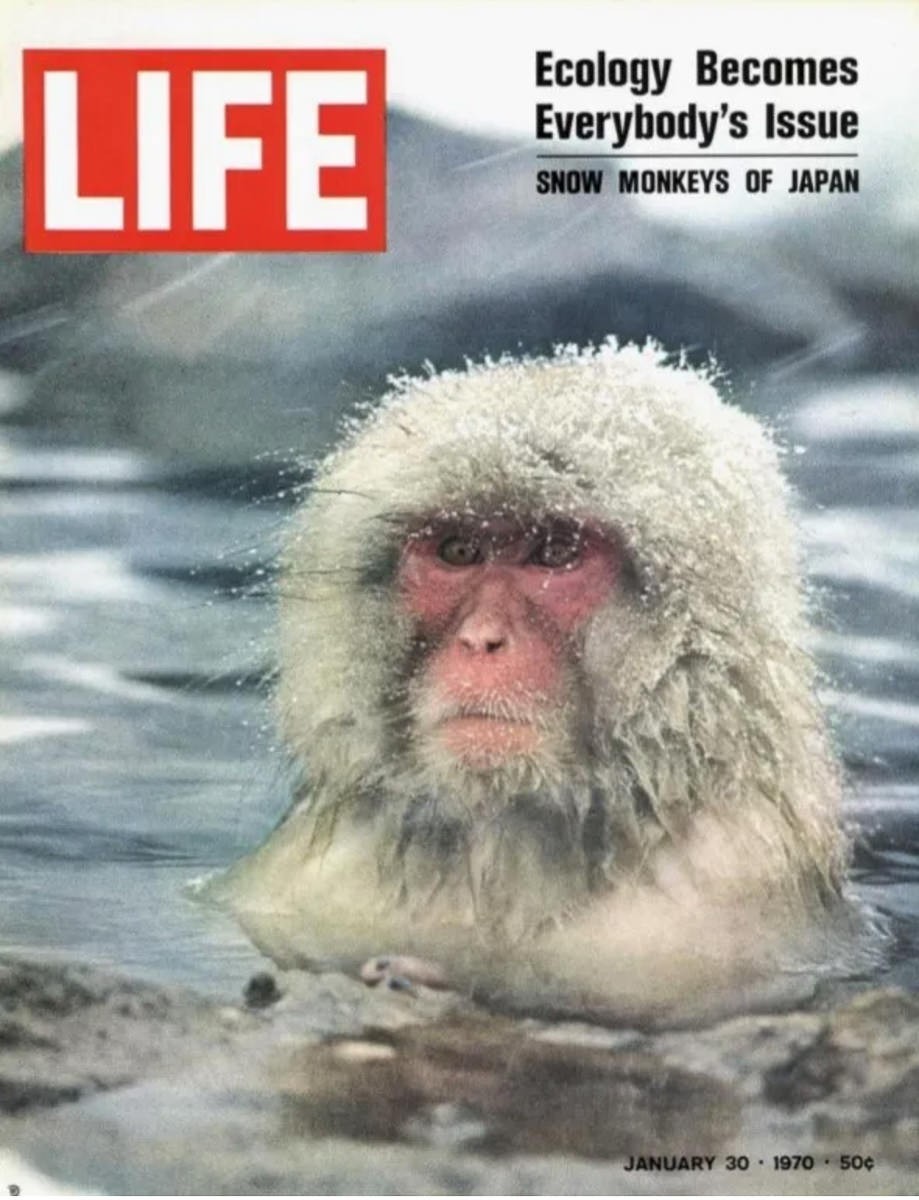
Even today, visitors can still observe them up close with their bathing ritual. Much to my surprise during my visit, the monkeys were unbothered by presence of people, despite our proximity. I only hope this is due to the collective good behavior of guests and that it continues to stay this way.
the Japanese macaques at Jigokudani are the only known group of macaques that engage in the act of bathing in hot springs.
If you want to jump straight to the information and FAQ about the monkey park, use the links below for quick access. Otherwise, you can read about my experience and whether I recommend visiting the Jigokudani Monkey Park.
Visiting The Nine Bathhouses Of Shibu Onsen | How To Get To Jigokudani Monkey Park | Day Trips From Nagano and Tokyo | Monkey Park FAQ | Best Time To Visit | Tips For Photographing The Monkeys | Where To Stay | Bathing With The Monkeys
Finally Seeing The Snow Monkeys Bathing
From Osaka To Yamanouchi
I have to start by saying that my visiting the Jigokudani monkey park goes hand in hand with my ryokan stay in Shibu Onsen and visiting the nine famous bathhouses. Together, it was an enchanting Japanese experience that I would gladly return to do again.
Getting here to the town of Yamanouchi from Osaka took me about 6 hours including the time between transfers at Nagoya and Nagano (directions from Osaka, Tokyo, and Nagano are below). Fortunately, I love riding the Shinkansen bullet trains and even the slower local trains have their charm. The whole journey did not feel long or difficult at all. I was also able to have a quick lunch in Nagano before jumping on the last leg train journey to Yudanaka.
Staying At Minshuku Miyama
Yudanaka Station is a small station in a small town where every ryokan and inn knows the train schedule by heart. I booked my first night with Minshuku Miyama and the owner came to pick me up shortly after I arrived. You just need to let them know which train you are arriving on ahead of time.
The inn is a traditional guesthouse with a gorgeous outdoor hot spring and it’s located very close to the trailhead for the monkey park. It’s walking distance, but the owner offered to drive me to the trailhead the next morning.
The lovely Japanese couple who run it barely speak a word of English, but have made efforts to have all the information you might need already translated and printed around the guesthouse. The wife cooks and prepares a kaiseki breakfast and dinner if you want to arrange it.
While it was still light out, I went for a short walk into Shibu Onsen, to pick up some sake and see the town where I’d be staying the next night. With that done, I could hardly wait to soak my cold body in the warm hot spring. To my delight, the hot spring was empty and I had it to myself that afternoon. There are few things as satisfying in life as standing in the cold open air and then slowly submerging your body in 41°C (105.8°F) water until only your neck up is exposed.
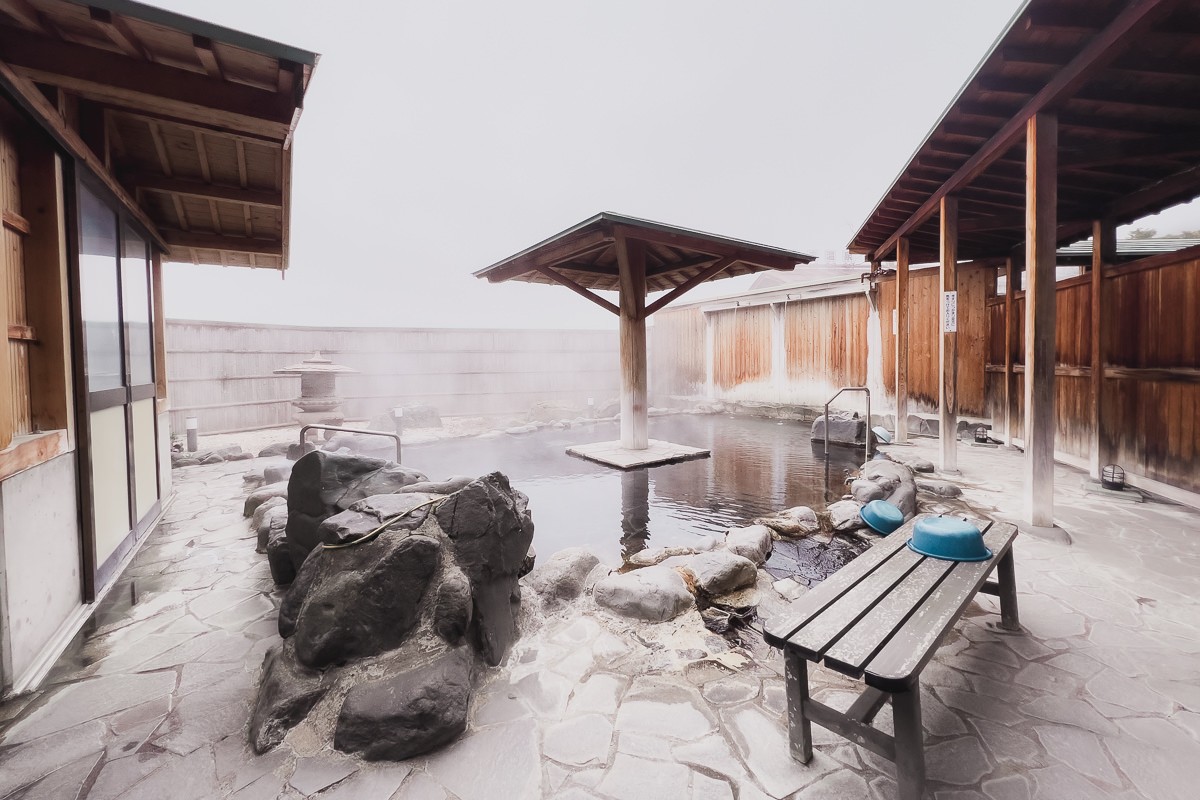
I stayed and let the warm and healing waters work its magic, removing the wear and tear of the 25000 steps a day I had been putting in the last week. I changed back into the traditional yukata provided and sat down for dinner.
The kaiseki experience is about having a small portion of many courses, a tasting menu of Japan’s many different dishes. It’s usually seasonal and local, depending on the chef’s preference and style. This formal dining experience is meant to be enjoyed slowly and deliberately, to take in the food both as nourishment and as an art form.
A Morning Walk To The Snow Monkeys
In the morning, I woke early to bathe again. Breakfast was a similar but a more modest affair with rice, mackerel, a fried egg and the accompanying vegetables, miso soup and various side dishes. When I finished, the owner dropped me off at the trailhead. The morning air was crisp from the mist that hovered above the tree line. I normally would be a bit creeped out to walk a dirt trail into the woods like this alone, but somehow it was very peaceful.
My brisk pace had me at the river and the Kurokukan ryokan in about 25 minutes. Here, I saw my first monkey, a cute and small furry thing, climbing nimbly across a braided cable over the river. And then another and more still climbing down from the rocky hillside. And I hadn’t even entered the monkey park.
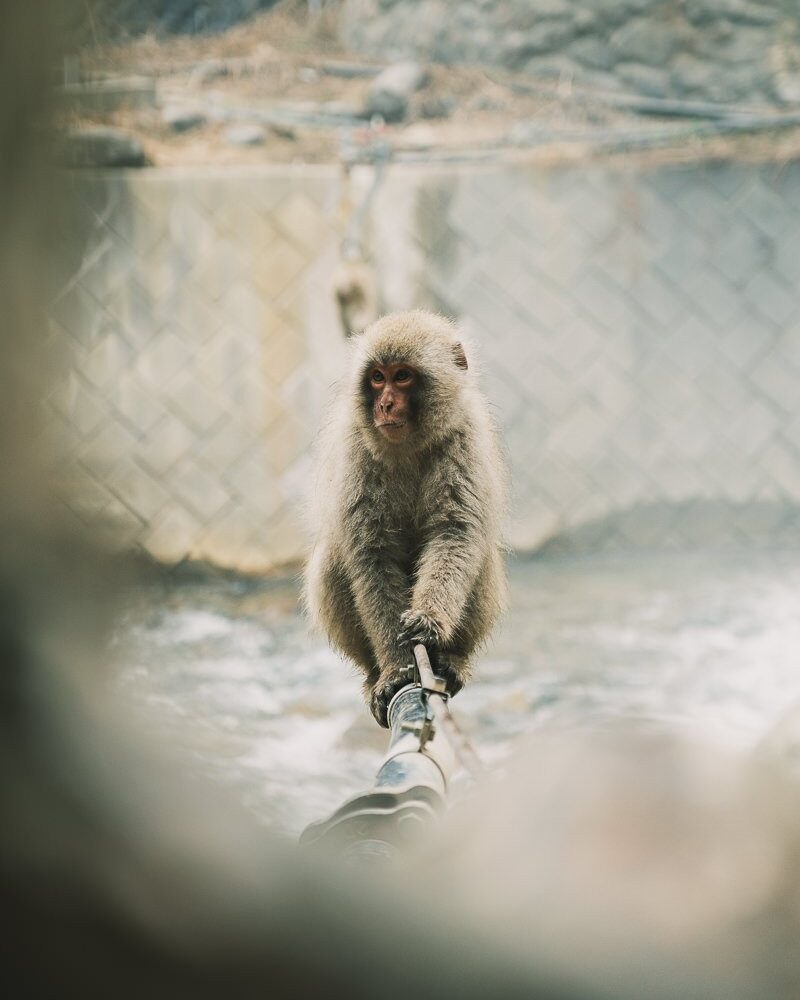
A set of stairs to my right indicated the final short climb to the park entrance. I paid my ¥800 entrance fee and warmed up for a few minutes inside the visitor center. Out the doors, a wooden pathway split into two paths, a set of stairs going down towards the river, and the other continuing towards the main hot spring pool. The monkeys were everywhere.
I saw a group running precariously alon the steep rock slope, some ambling along the slow moving part of the river, and others just sitting by the steps on the stairs. And finally the viewing area surrounding the hot springs. To be honest, I was a little underwhelmed at first. From afar, the pool looked a lot smaller than I thought it would be. And the viewing platform with its railing and barriers felt like…a view platform. I ventured closer.
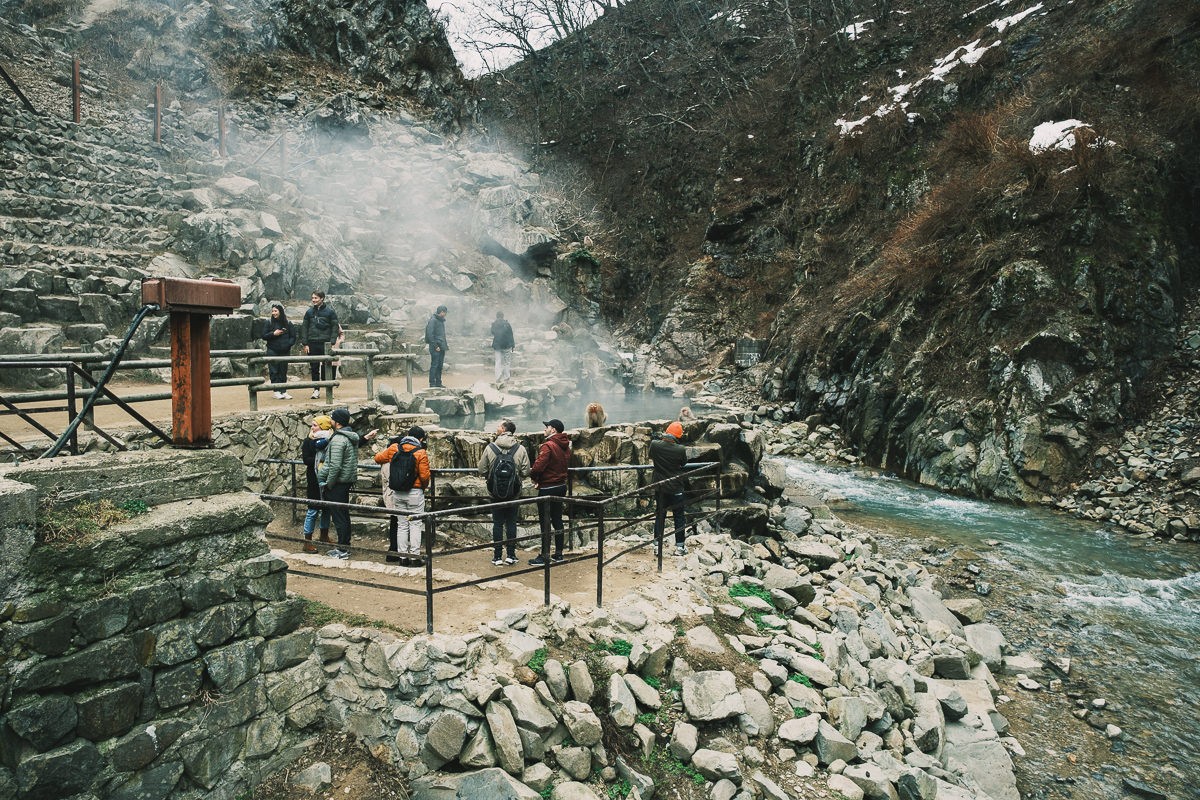
Like Looking Into A Mirror
And then I saw what I came to see. About a dozen monkeys scattered in different parts of the pool, some submerged, others just hanging out on the edges. Up close, I noticed the rails and barriers were more off to the side, leaving a completely unobstructed view of the pool and the monkeys. I observed for a while and then took out my camera.
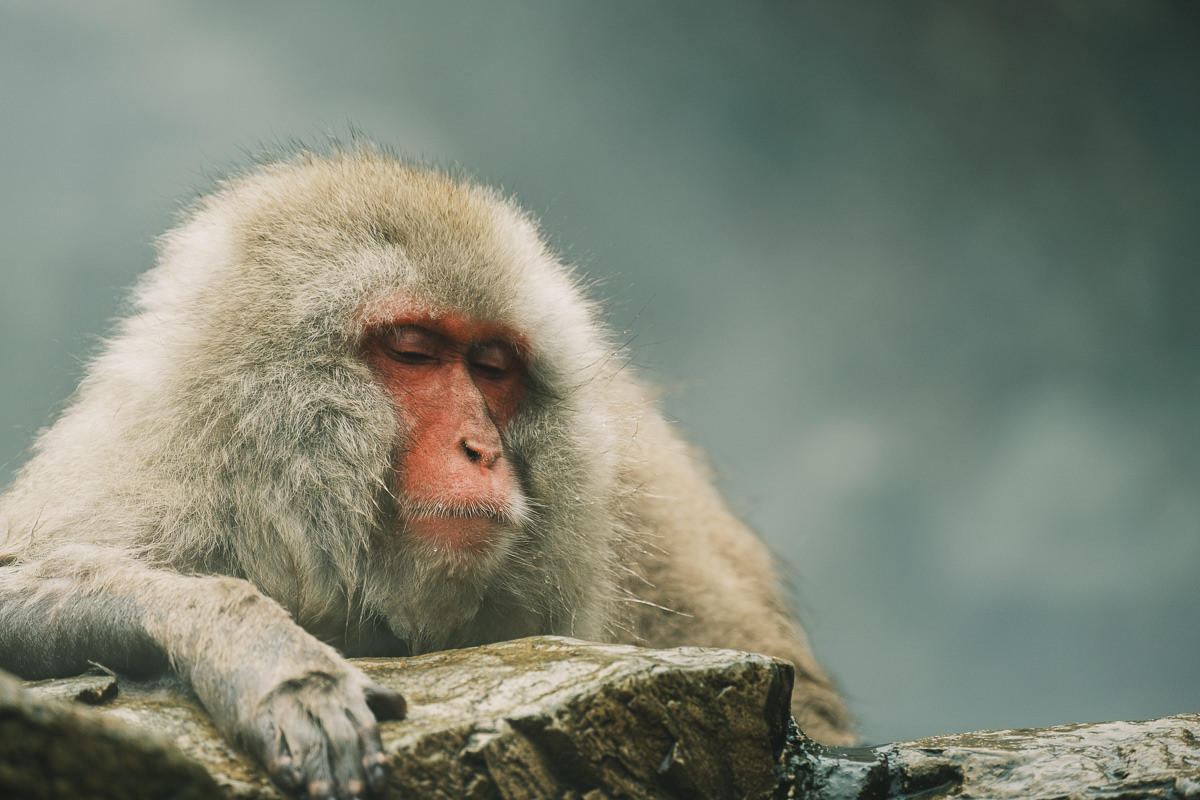
I really didn’t know what to shoot because so much was happening. There was the monkey with his eyes closed, the ones grooming his friend, the monkey napping off on the side, and the mother shielding her little baby from the cold.
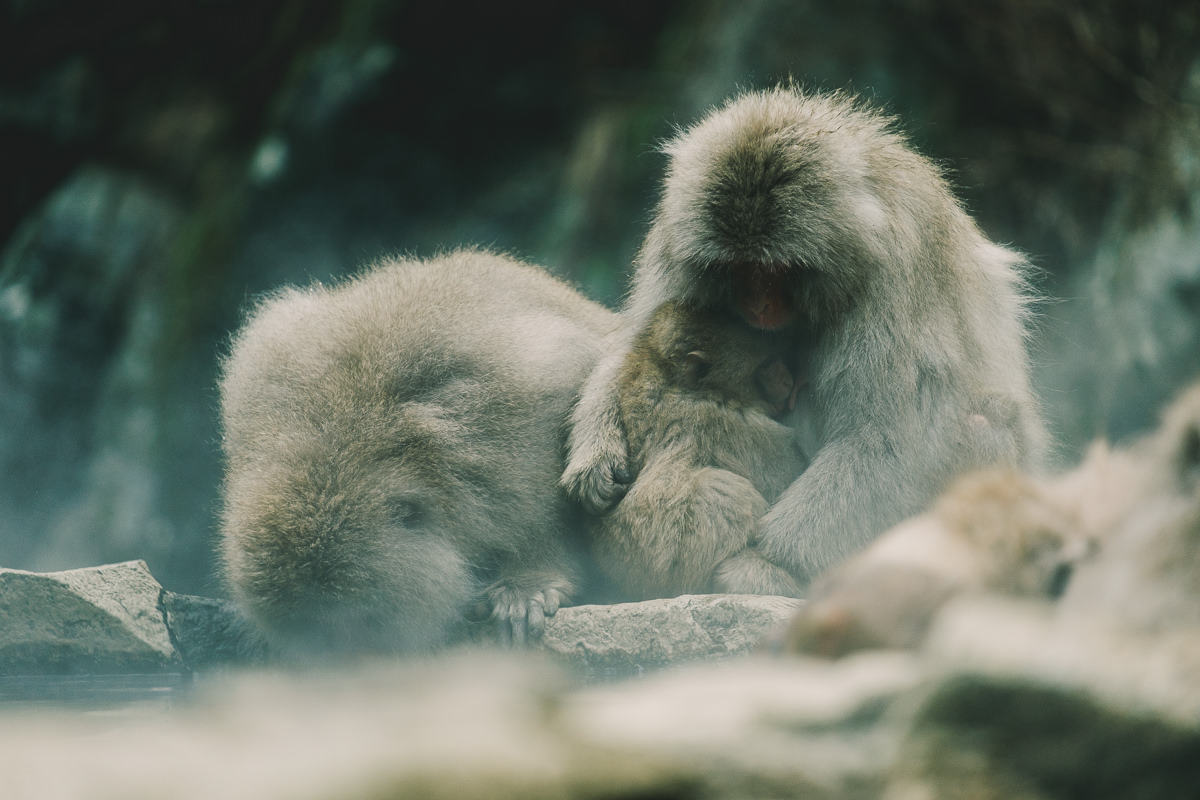
Some were fully soaked and looked cold, but for reasons unknown was standing out of the water. Another two were playfully biting at each other. Some were dry from the parts not submerged. I would have been one this one, head down in my own world, ignoring all the other annoying monkeys.
The part I did not expect was just how human like their expressions and behavior were. I know that’s what everyone says, but you just have to see it for yourself in person. There were times when a monkey was looking directly at me or my camera, and I wondered what was going on in its head.
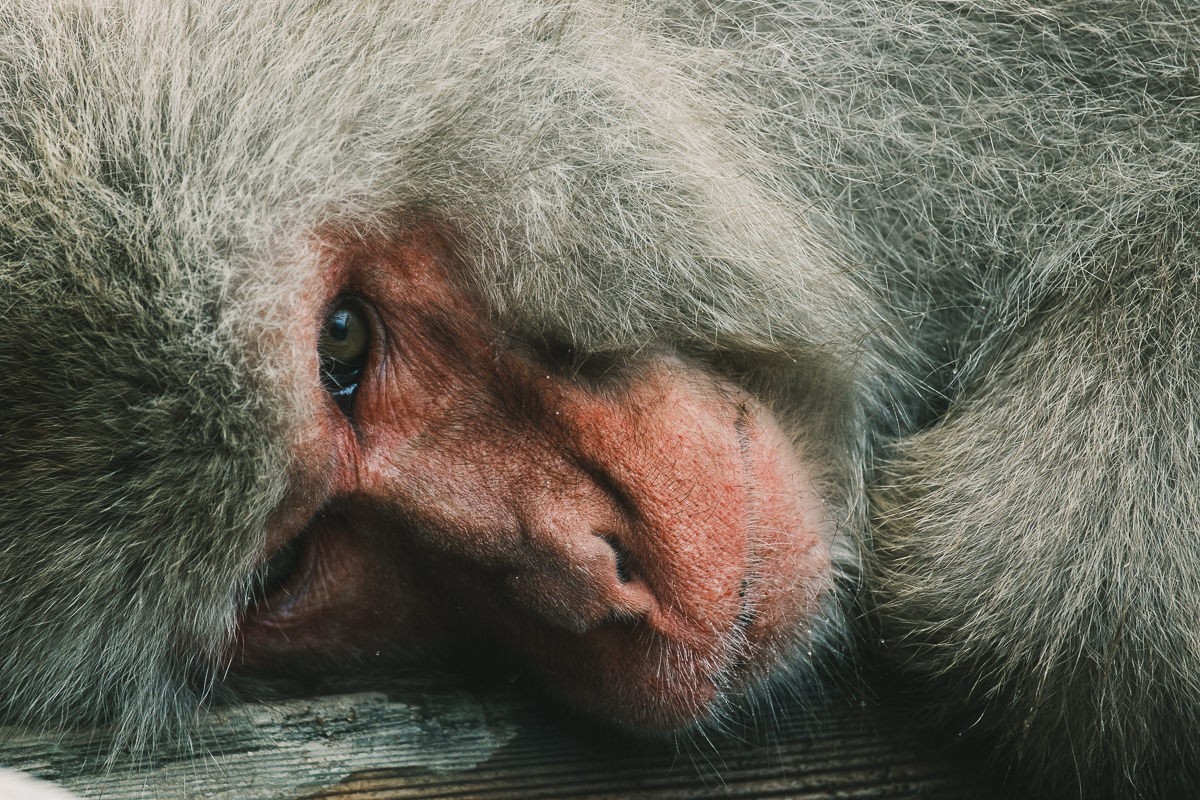
What A Civilized Place
Unlike the monkeys I’ve encountered in Thailand, Indonesia, or India that were a menace and animalistic, these creatures came off as having much higher intelligence and emotions. On their faces, I saw contemplation, concern, and relief. Some faces showed curiosity and others, boredom? Some even looked like they were just staring off into space and daydreaming.
One even looked at me the way I’d look to the side at a friend while getting a haircut and unable to turn my head. Exactly like that. Can you see it?
I spent about 1.5 hours here, taking a break every 20 minutes or so to warm back up. I visited in March when the snow had melted away, but it was still blistering cold. Plenty of times, there would be monkeys running by or walking alongside my path. What struck me was how calm and collected they seemed walking by. Usually, monkeys are a bit more jumpy and would scuttle about. These monkeys just seemed so civil and proper?
Except when they are picking as their asshole, but who doesn’t do that from time to time?
As far as the other park guests, I did find that most people were being very respectful and keeping their distances, even when the monkeys came close. People took photos and films, but I didn’t see any of the bad tourist behaviors. And no one tried to get an up close selfie.
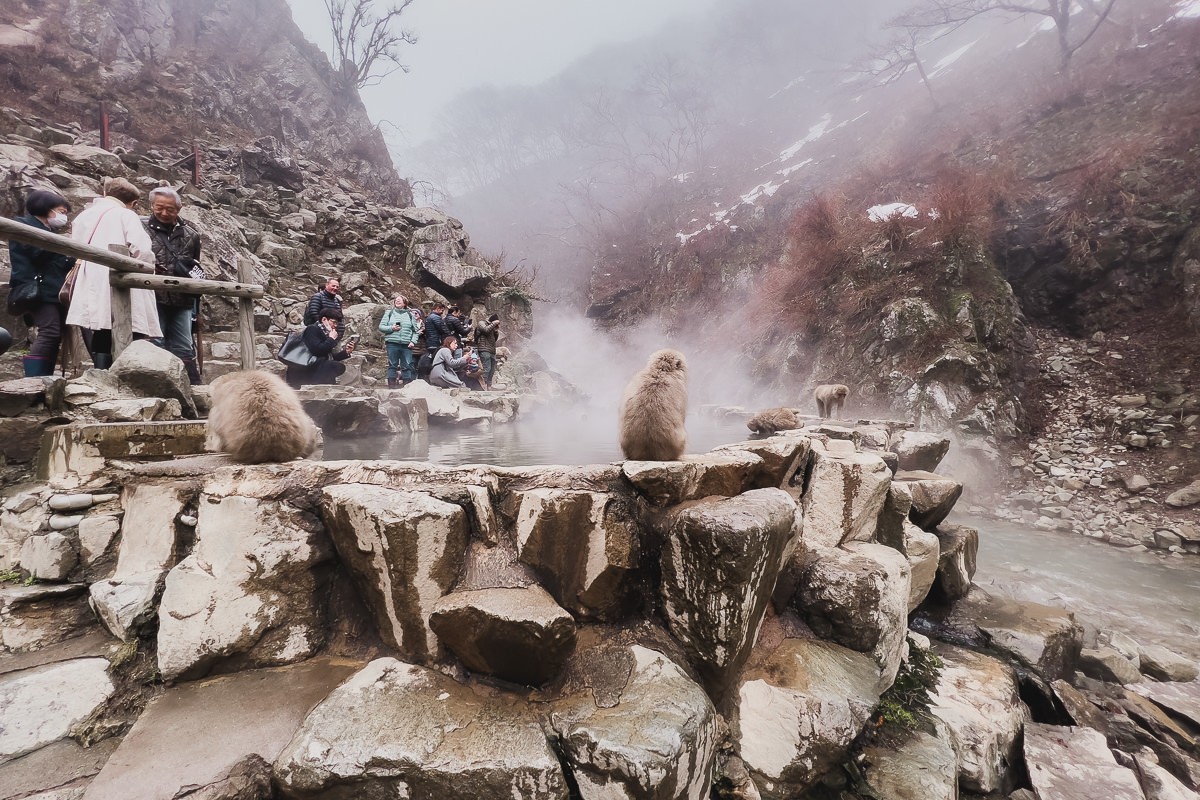
I really think this is why the monkeys are used to us, in a good way. It’s easy to see incidents that could force the park to erect more barriers for the monkey’s protection and ours.
Don’t Settle For An Imitation
On my next trip to Japan, I saw advertisements for a monkey park in Hakodate where guests can “come see the famous snow monkeys bathing.” Out of curiosity, I ventured out to the Hakodate Tropical Botanical Garden. As soon as I entered, I knew I’d be disappointed by what I’d see.
Unlike the natural surroundings at Jigokudani Valley, this was an artificial open-air enclosure just like what you’d see at a zoo. On one side was a dirty pool and the rest was looked like a dilapidated playground. Monkey feces was everywhere, and guests were encouraged to throw snacks down at the monkeys.
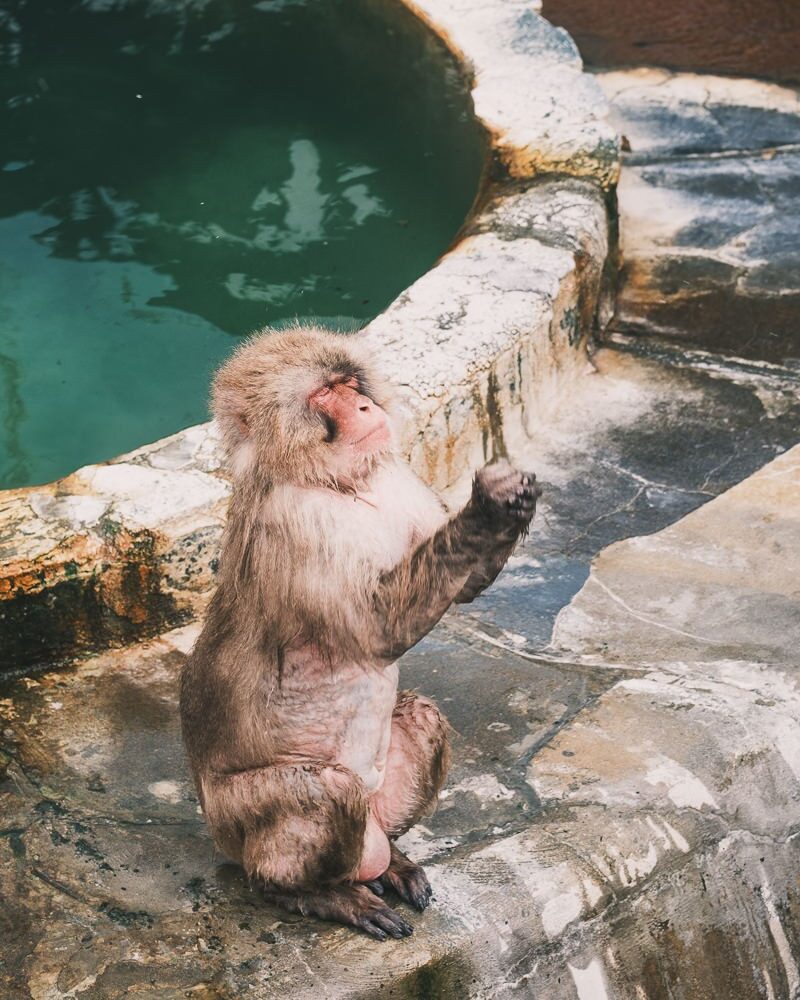
I don’t know the full story behind why the monkeys are here, but I’d be hard pressed to believe it’s anything other than people taking these monkeys from the mountain and keeping them here in the zoo. Avoid the monkey park in Hakodate. If you want to see the snow monkeys bathing, make the trip out to Nagano to visit the Jigokudani Monkey Park.
Coming from Tokyo? It’s much more efficient to join this group day trip with van transport between Tokyo and Jigokudani monkey park and avoid all the train and bus transfers.
Visiting The Nine Bathhouses Of Shibu Onsen
I finished my visit and hiked back out to the parking lot. Here, a driver from my next ryokan came to pick me up. To complete the other half of my bucket list adventure, I booked into the Suminoyu ryokan in Shibu Onsen, one of the nicest hot spring hotel in town. The imperative word here is ‘in town.’
What’s special about Shibu Onsen is that in addition to all the private baths at each ryokan, there are nine public bathhouses that the locals use. Guests staying in the Shibu Onsen town proper, receive a key during their stay that opens up all nine bathhouses.
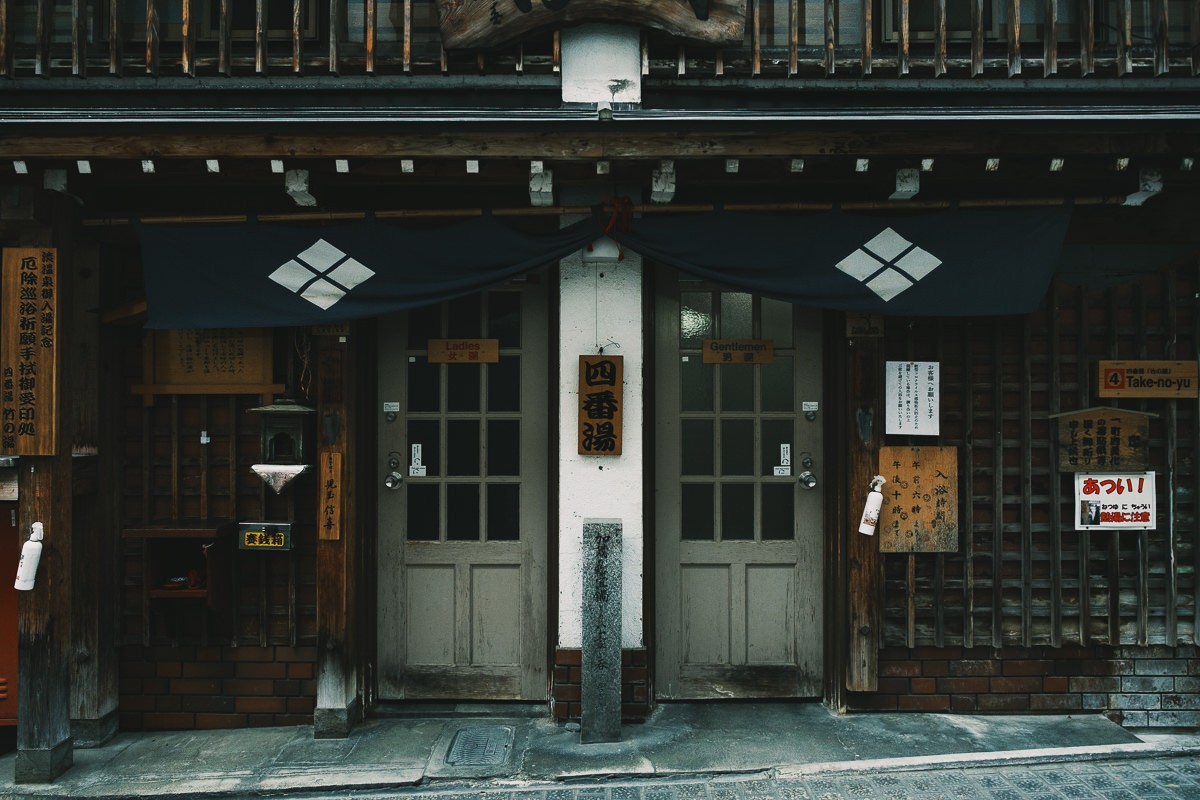
To Good Health and Fortune
Local legend has it that visitors who bath in all nine bathhouse, each with its own medicinal properties, and collects all nine stamps onto a tenugui towel will be blessed with good health and fortune. I definitely could use both, so I was determined to complete the challenge that afternoon.
You can read about my full experience here in my Full Guide To Shibu Onsen And The Nine Bathhouses to help you plan your own trip. I’ll give you a Cliffs Note version here.
Like my stay at Minshuku Miyama, the room at Suminoyu was a traditional type of Japanese accommodation, where I would be sleeping on a shikubuton (Japanese futon) over the tatami mat floor. Ryokans provide yukatas (light kimono robe) along with a hoari (outer robe). In the winter, they also provide an even thicker outer robe for walking outside.
I completed the look with a pair of wooden geta (sandals) and tabi socks (toe socks) and prepared my basket with my normal towel and stamp towel ahead of going out to the bathhouses.
Starting With Lucky #6
Each bathhouse has a number on the outside and is split down the middle separating the men’s bath from the women’s bath.
The closest one to me was bath #6, so I started there. The water in this bath was supposed to treat eye diseases (mearai-no-yu). Unlocking the door with the key, I felt like I was about to embark on an adventure in a different world. In reality, it opened into a small locker room type area to remove all my clothes. Behind another door was, well, a bath. I’m not sure what I was expecting, but it was not this.
My previous experiences with onsets have been public ones that were much larger. This was enough to accommodate two to three people before things got awkward. Luckily, I was the only one in there at the moment. As directed, I rinsed my body using the small bucket and got in. And then I just sat there. I mean, it was a hot bath and I loved the reprieve from stepping out of the cold and into warm water, but it was still just a small bath. It took me a few minutes, but I finally settled in and relaxed. It was nice.
After about 15 minutes, I realized that I had 8 more of these bathhouses to visit around the town, so I dried off and put on my yukata, then the belt, then the haori, and finally the outer coat. Before leaving, I make sure to stamp my towel. 8 more to go.
8 More Bathhouses
A few minutes later, I’m standing inside the locker room of bath #7. This one is for injuries and trauma (nanakuri-no-yu). I go through the motion of unrobing: the outer coat, the hoari, the belt, and then the yukata. This one looked a bit dingier and smaller, but I get and repeat the process. I only stay about 10 minutes here. With a quick calculation, I estimated that it would take me at least 2 more hours to complete the circuit of walking, unrobing, bathing, robing, stamping and walking if I spent 15 minutes for each bathhouse.
You get the idea. 2.5 hours, warm and pruned, I returned to my ryokan, completely onsen-ed out, but with the satisfaction of getting every stamp for my towel and completing the challenge.
I actually had a lot of fun exploring all the bathhouses, and I think it would have been even better if I was doing this with a friend or partner.
My ryokan had its own indoor and outdoor bath, but I’d save that for the next morning, getting in one last long soak in the morning before catching my train back to Nagano and onwards towards Tokyo to finish my trip.
Below you’ll find all the relevant information for getting to and accessing Jigokudani as well as a FAQ about the park and the monkeys. Bookmark this page if you’re planning a trip so you have all the information you need at your fingertips.
Getting To Jigokudani Monkey Park
The closest town to Jigokudani Monkey Park is Yamanouchi, about 50 minutes away from Nagano. In this area, you will find Yudanaka Onsen and Shibu Onsen, two hot spring villages in the town and an excellent base for visiting the monkey park.
From Tokyo
The fastest way from Tokyo is to travel by the JR Hokuriku Shinkansen (bullet train) from Tokyo Station to Nagano Station. The journey takes roughly 1 hour and 35 minutes and costs ¥8340. This train is included with your JR Rail Pass. At Nagano Station, follow the directions ‘From Nagano’ below.
By car, it takes about 4 hours to travel from Tokyo to Yamanouchi via Nagano. The distance is between 275 – 325 km depending on the route you take.
From Osaka
The fastest way from Osaka is to travel by the JR Tokaido-Sanyo Shinkansen from Shin Osaka to Nagoya Station (50 minutes and ¥6680) and transfer to the JR Shinano Limited Express (3 hours and ¥7460) to Nagano Station. Both JR trains are included with your JR Rail Pass.
At Nagano Station, follow the directions ‘From Nagano’ below.
From Nagano
1. From the Nagano Station, take the Dentetsu Nagano Line train to Yudanaka Station. The train ride is about 50 minutes with the last stop at Yudanaka Station and costs ¥1290. This train is not covered with your JR Rail Pass.
Alternatively, you can take the Express Bus To Shiga Kogen (40 minutes and ¥1800) straight to the Snow Monkey Park parking lot and trailhead and skip step 2.
By car, the drive from Nagano Station to the trailhead parking lot is about 58 minutes and the distance is about 35 km.
2. At Yudanaka Station, you can take a 10 minute bus to the Snow Monkey Park parking lot and trailhead. ¥310.
TIP: Every ryokans and hotel in the town will provide transportation from Yudanaka Station.
3. Follow the signs for the trailhead and hike roughly 35 minutes on a dirt path towards Korakukan Hot Spring Hotel. You will eventually see the rustic old hotel on your left across the river. Almost there. Before the bridge, take the set of stairs on your right with the big sign that says Snow Monkey Park. Follow it up to the entrance.
TIP: The trail has a moderate difficulty with a combination of stairs, dirt trail, and paved walkway. From the stairs at the trailhead, it is 1.7 km to the entrance with inclines and declines. I strongly recommend micro-spikes during the winter months when the path is icy and slippery. A set of collapsible trekking poles will also be helpful for steeper sections.
Day Trips To Jigokudani Monkey Park
While I highly recommend combining a visit to the monkey park with a night at in the Shibu Onsen village, it’s possible to visit the park as a day trip from Nagano or even Tokyo.
How To Visit The Snow Monkey Park From Nagano
It takes about 2 – 2.5 hours to get from Nagano Station to the Jigokudani monkey park including the local train to Yudanaka, a bus to the trailhead, and the 35 minute hike entrance.
If you don’t want to do this on your own, Machinovate puts together a pretty efficient trip from Nagano starts with a morning guided visit to the Zenko-ji temple, followed by a traditional Japanese lunch, a sake tasting visit to the Nishinomon-Yoshinoya Sake Brewery and finally a visit to the Jigokudani monkey park before returning to Nagano at around 5:30 pm. You can also book the trip here.
How To Visit The Snow Monkey Park From Tokyo
It takes about 4 hours to get from Tokyo Station to the Jigokudani monkey park including a Shinkansen to Nagano, a local train to Yudanaka, a bus to the trailhead, and the 35 minute hike to the entrance.
Practically, it’s much more efficient to join a group trip that goes straight by van transport between Tokyo and Jigokudani monkey park without all the transfers. This full day trip includes transport to the park from Tokyo, a sukiyaki lunch, and between January 26 – February 20, a stop at the Kamakura No Sato ice village to see the snow igloos.
I’ve recommended this trip to some friends visiting Tokyo and wanted to see the monkeys. They said the ride was about 4 hours with a 15 minute break, the the guides were great, and they loved the monkey park. Not including the hike there and back, they had about 45 minutes to spend at the monkey park and they were able to rent cramp-ons to walk on the icy path to the park. They also enjoyed the lunch and said it was filling.
Jigokudani Monkey Park FAQ
1. How Much Are Entrance Tickets?
It’s ¥800 for adults and ¥400 for children.
2. When Is The Park Open?
The park is open daily from 9:00 am to 4:00 pm (Winter), and 8:30 am to 5:00 pm (Summer), indicated otherwise on their website. See the daily opening times at the top.
3. Are The Monkeys There All The Time?
The monkeys are wild and are not always there at the park. They come down from the mountains in the morning and return to the mountains in the afternoon. Check the official website for their weekly forecasted times when the monkeys will visit the park.
4. Can You Feed The Monkeys?
No. Once upon the time, the park experimented with allowing visitors to feed the monkey, but they noticed the monkeys getting aggressive. The park no longer allows visitors to feed the monkeys. They are fed by the park a few times a day during the winter to supplement their diet. It is enough food while they are in the park, but not enough to survive, so they are not dependent on the park for food.
5. Are The Monkeys Wild?
Yes. The monkeys are wild and visit the park when they want. Their presence in the park is not guaranteed, though it is expected, especially during the winter months between December and March.
6. Are The Monkeys Aggressive?
The monkeys are generally quite relaxed and peaceful. While they are used to the presence of people, guests are advised not to get too close or try to touch the monkeys. They are, after all, still wild animals. Don’t mistaken their calm and gentle demeanor to mean you can get close and try to play with them. Respect the rules please and let’s keep this place the way it is for future visitors.
When Is The Best Time To See The Snow Monkeys?
The snow monkeys can be seen year round during the day when they come down from the mountains to bathe and play in the hot springs. During the winter months, they stay at the park for longer hours due to the warm hot spring water and the supplemented feeding due to the greater scarcity of food. They usually forage for food in the mornings before visiting the park and then return to the mountains at night to forage for food and sleep.
During the summer monkeys, you can find the monkeys playing in the water, but they will have shed their iconic fluffy fur coat. This is not really the best time to visit.
The best time to visit the Jigokudani monkey park is between the winter months of December and March. The cold and snowy backdrop makes for a more dramatic and picturesque scene. During these months, the monkeys will have grown out their thick and fluffy fur coat and resemble the cute creatures you’ve come to expect from the photos.
It’s important to note that it is extremely cold during these months and the trail to the monkey park can be slippery and dangerous. I can’t emphasize enough how important it is to have proper winter hiking footwear and I strongly recommend carrying portable micro-spikes.
Tips For Photographing The Snow Monkeys
1. Carry A Telephoto Zoom Lens. I expected before visiting that having a good telephoto zoom lens would be important. And I was correct. I shot with my Fujifilm X-H2 (my favorite camera) and the 55-200mm lens. The X-H2 is an APSC camera so the crop factor on the lens makes it a 300mm equivalent on 35mm full frame cameras. This was plenty of reach to comfortably capture the monkeys close up without having to get too close.
What I didn’t expect was how close I could get to the monkeys. There were so many instances where a monkey would just be walking right behind or beside me. In other words, you can probably still capture them even with your phone camera.

2. Don’t Interact With Or Obstruct A Monkey’s Path. Unlike the monkeys in Thailand and Indonesia that have learned to steal your phone and food, these monkeys are so well behaved and pleasant. They seemed more or less used to the visitors and didn’t mind walking by us. I didn’t notice any aggressive behavior, but that’s also in part due to the good behavior of the visitors. Don’t get in their faces to take a photo or walk alongside them to film. Your movements could agitate the monkeys.
3. Get Low. I found the best angles were as close or level to the water as possible. There are many places where you can find this angle, so move around. Just be mindful of your surroundings and others.
4. Observe Their Behavior. I think the original fascination with the early photographs of the monkeys was their human-like expressions and behavior. I’ve seen all sorts of monkeys, chimpanzees, and gorillas in their environment, but I’ve never seen such a close resemblance to us as I did observing these Japanese macaques. The way they relaxed in the hot springs, how they embraced their offsprings, and even their interactions with each other.
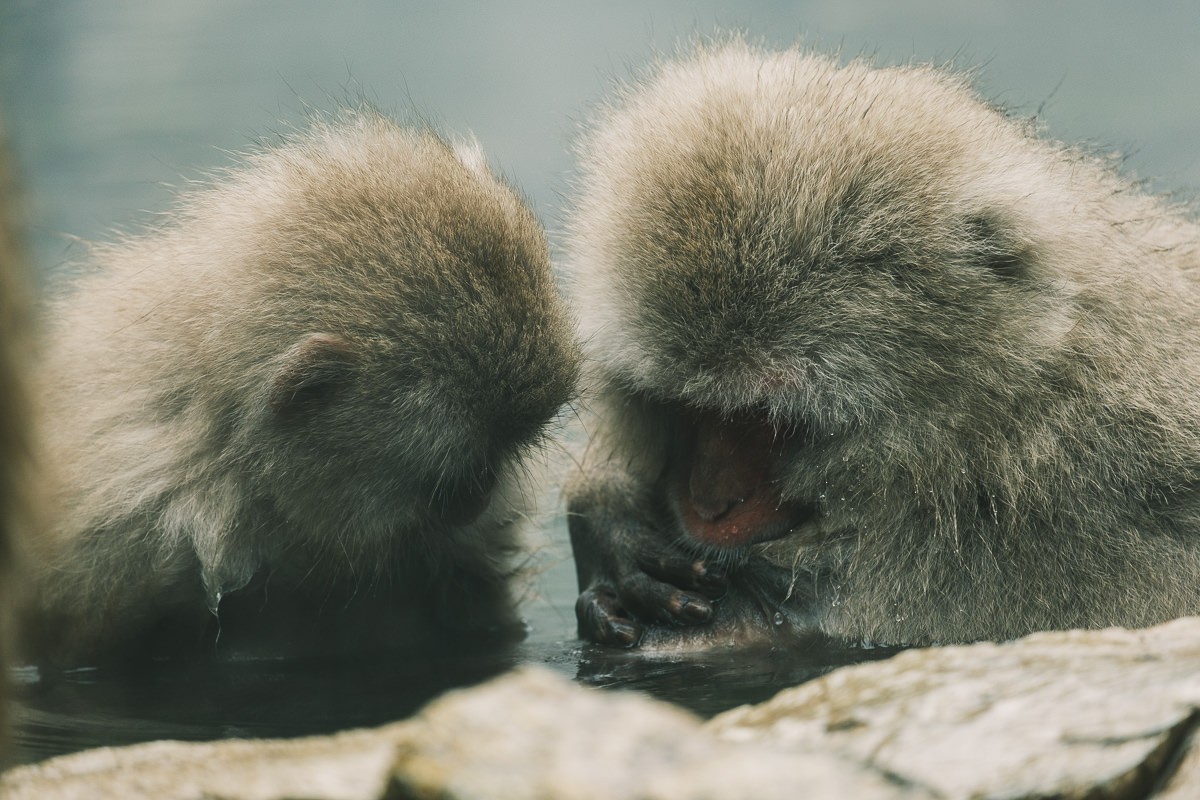
Capturing these moments will make more the best photos. This definitely is exactly what I look like when my girlfriend scratches me or searches for gray hairs on my head.
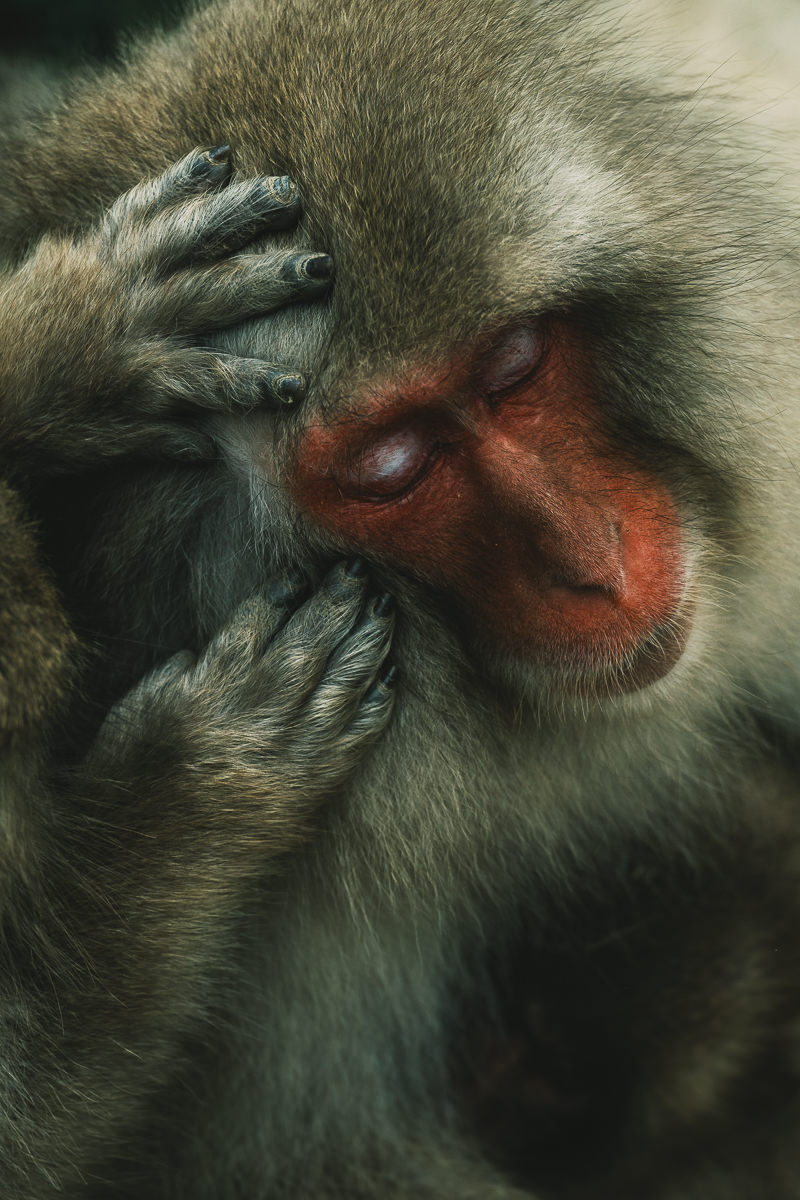
Where To Stay In Yamanouchi
I stayed the Suminoyu ryokan, which I can highly recommend, but below were the other ryokans on my list while I was searching. One was already booked out, another I decided to save for a return trip with my girlfriend. I found a couple of economical guesthouses that were good options for solo travelers.
If you’re planning to visit Jigokudani, I recommend staying in Shibu Onsen. Not only is it close to the park, the streets are quaint and historic – this town has been a hot spring pilgrimage destination for over 1300 years. And remember you only get the keys to the nine bathhouses if you are staying in Shibu Onsen.
For those looking to stay near the station, Yudanaka Onsen offers beautiful and economical ryokan options. You won’t get access to the nine bathhouses, but the ryokan’s private baths are all nicer anyway.
Recommended Hotels In Shibu Onsen
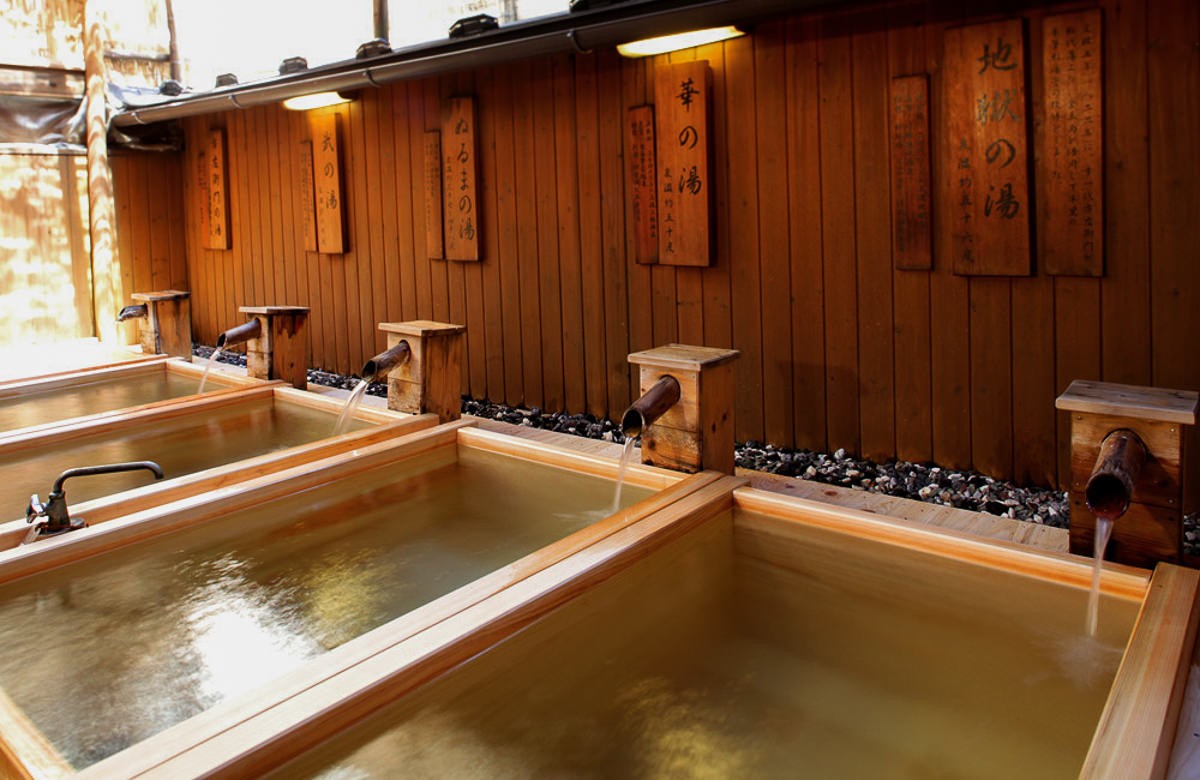
Kokuya Ryokan was established in 1625 and is currently managed by the 16th generation of the family. Between the kaiseki dining and the baths, this is place to go for the full ryokan experience at its best. If you can find a partner offer rate, it’s an amazing deal.
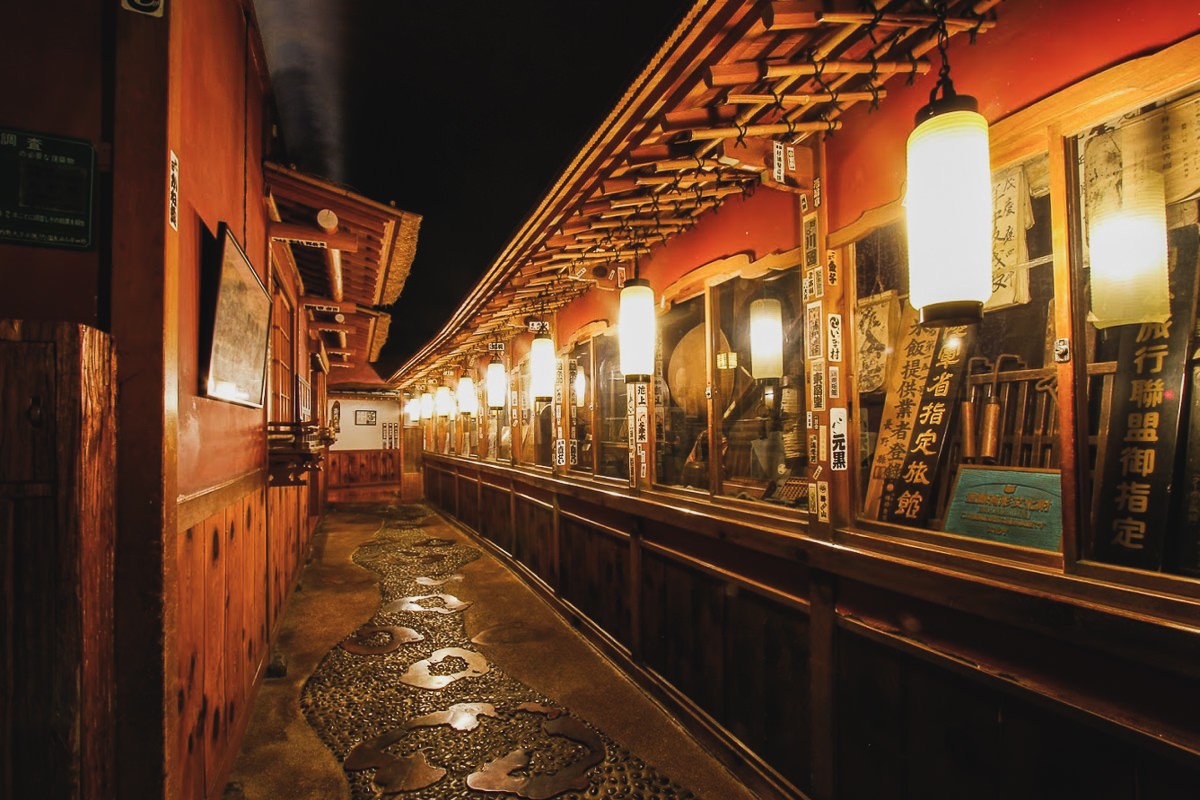
The old Kanaguya Ryokan wooden building dates back over 250 years and is the most iconic landmark in Shibu Onsen. The narrows corridors lit by traditional lanterns definitely give Ghibli vibe – especially at night. It’s easy to see why people think it was an inspiration for Hayao Miyazaki’s animated masterpiece, “Spirited Away.”
TIP: Use the hotel’s website to search for date and room availability. Then book here for a better rate than the hotel’s official prices.
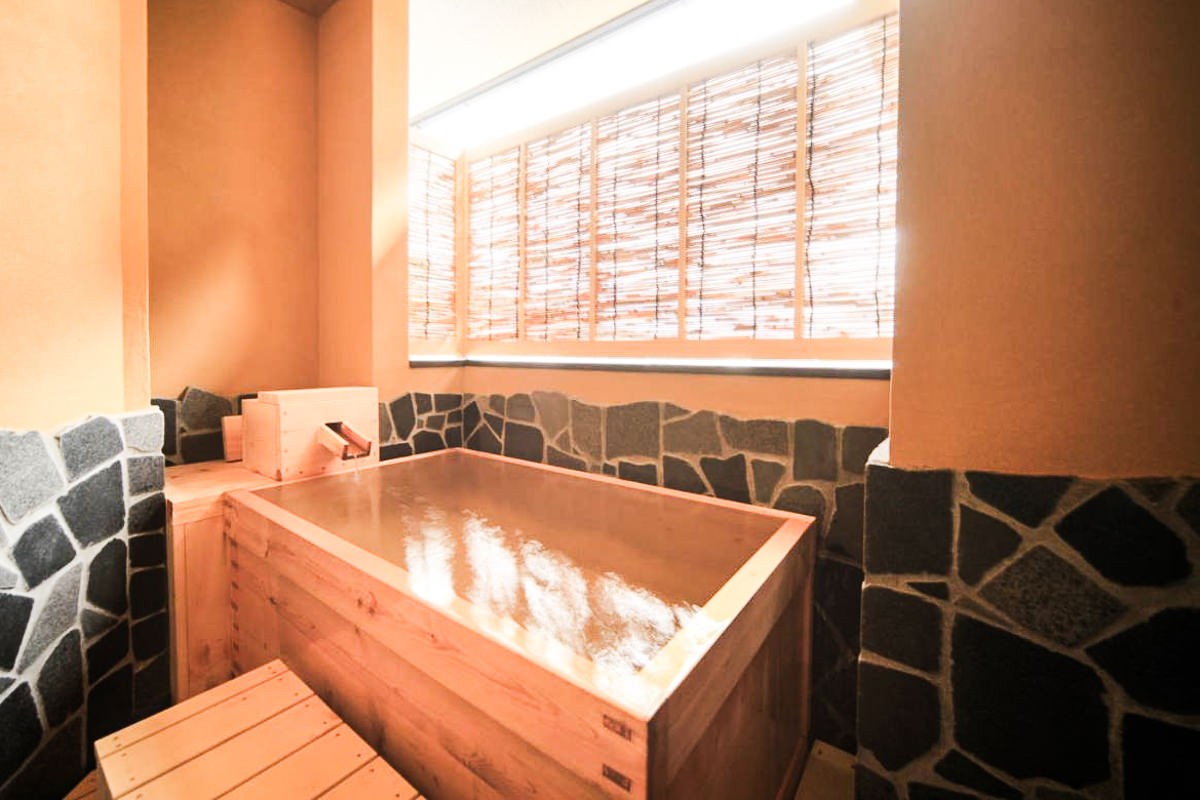
Wafu-no-Yado MASUYA. This placed checked every box as far as offering an authentic ryokan experience. The decor is traditional, the menus are well reviewed, and the baths are just beautiful.
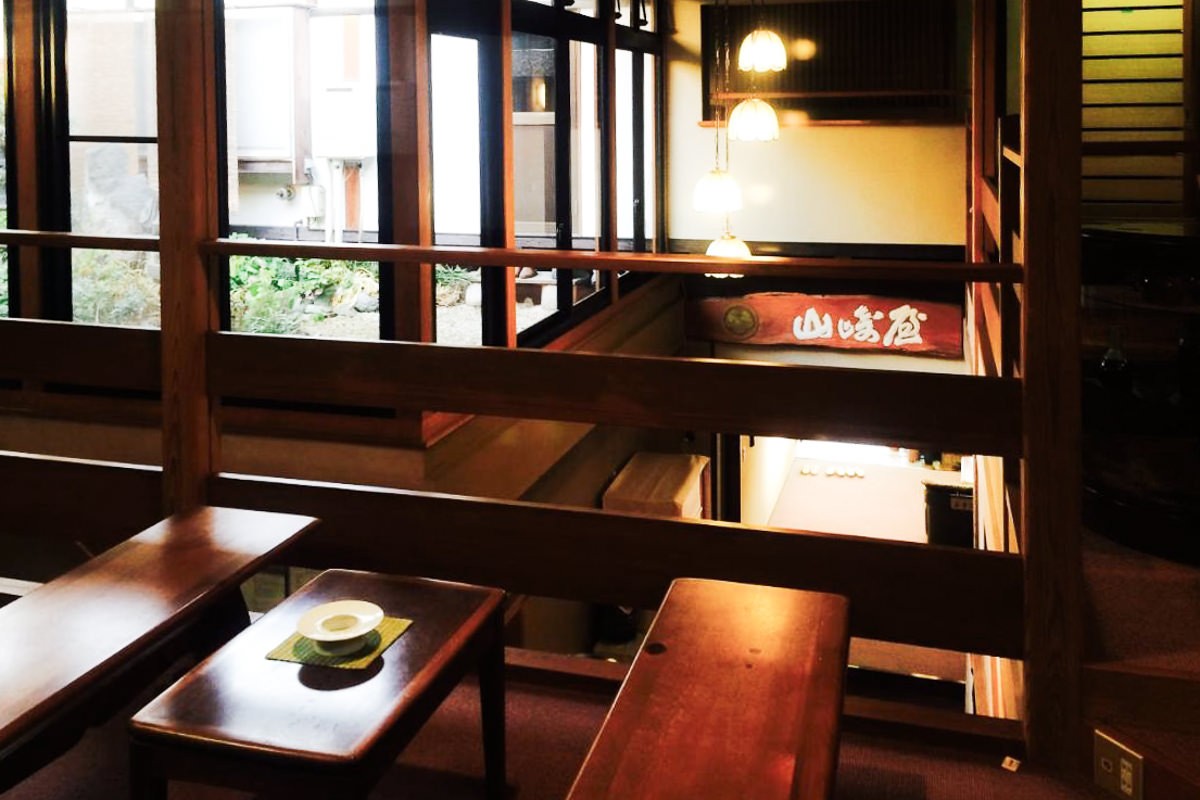
Yudanaka Onsen Yamazakiya. This simple ryokan is great for solo travelers and is one of the cheapest accommodations in Shibu Onsen.
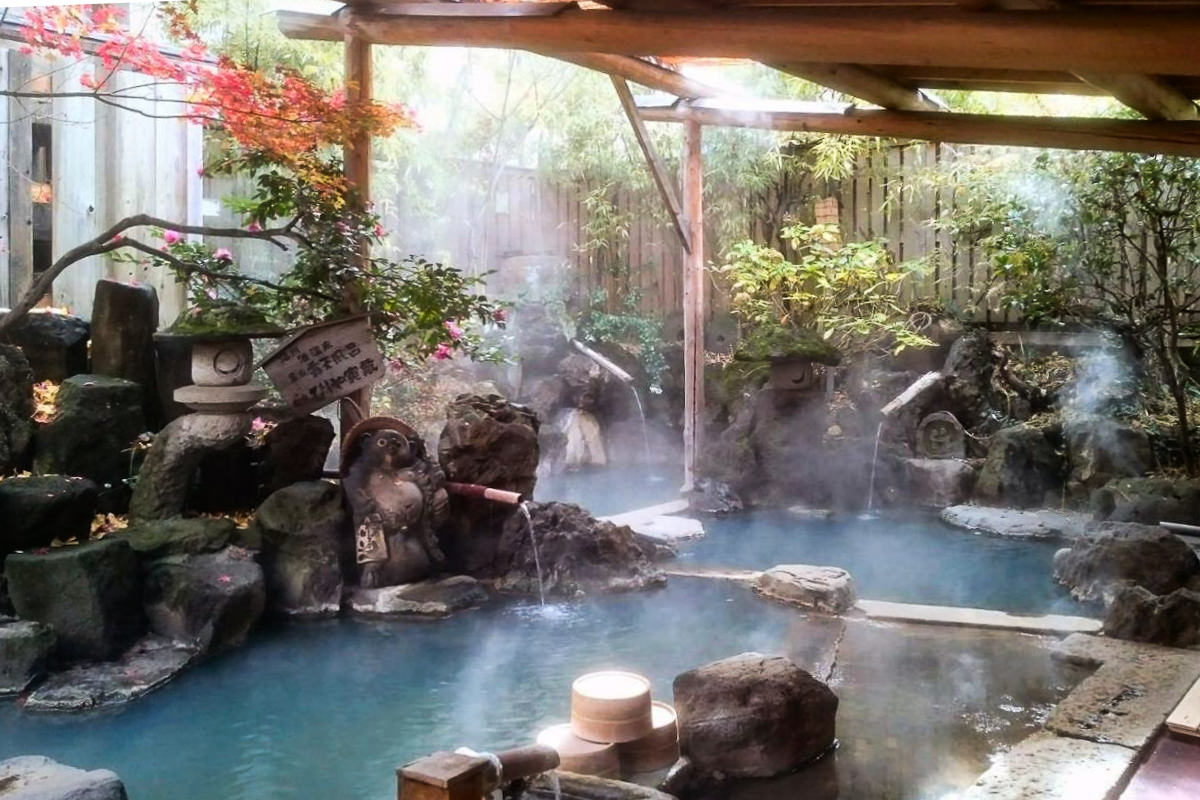
Onyado Hishiya Torazo. Tucked away in a small alley by bathhouse #9, this little oasis is well-liked by guests for its baths and traditional cuisine.
Recommended Hotels In Yudanaka Onsen
I initially searched for hotels in Yudanaka Onsen because of the train station. While not as charming as Shibu Onsen, Yudanaka ryokans are stunning and it’s a bigger town with more options for restaurants. It is a bit further out than Shibu Onsen, but still close enough to be an easy base for the monkey park. Here were the top hotels that were on my list before I turned my attention to Shibu Onsen.
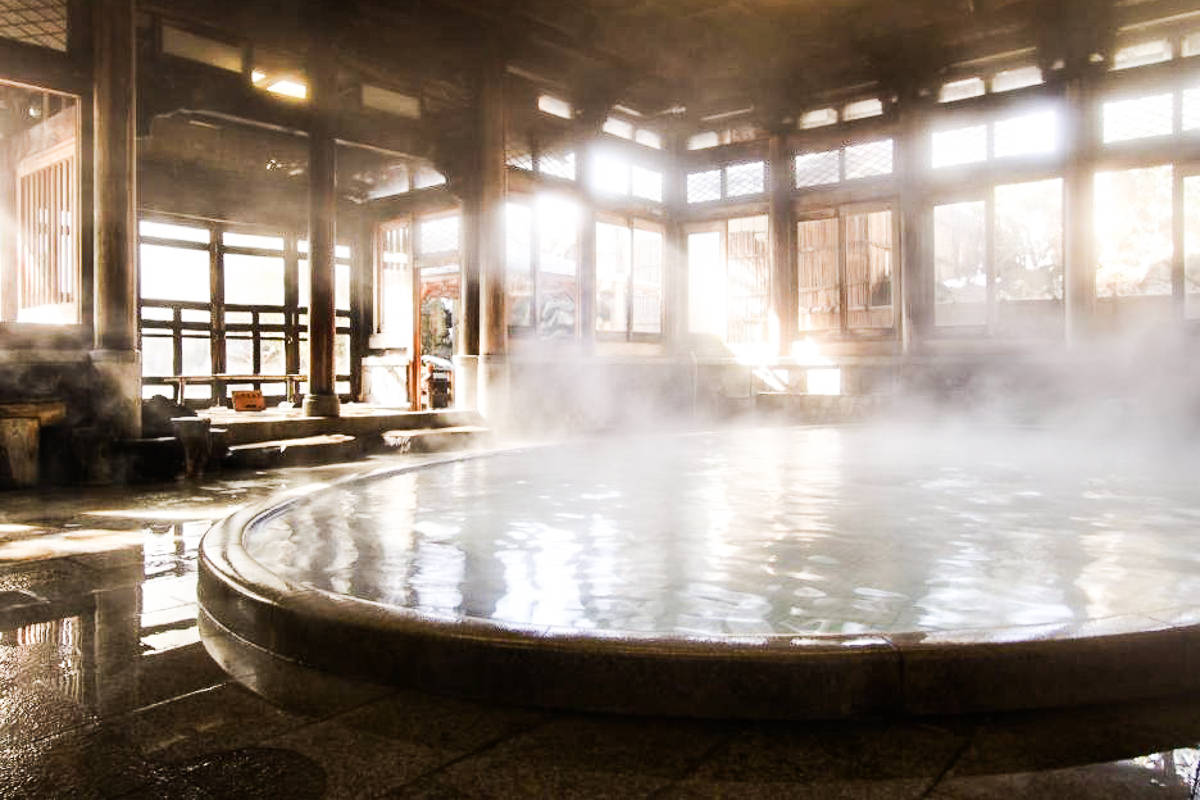
Yorozuya. I would return here with my partner. The baths look amazing and the stay comes with the full kaiseki breakfast and dinner experience. You don’t get access to the nine bathhouses in Yudanaka, but I the one they have is enough.
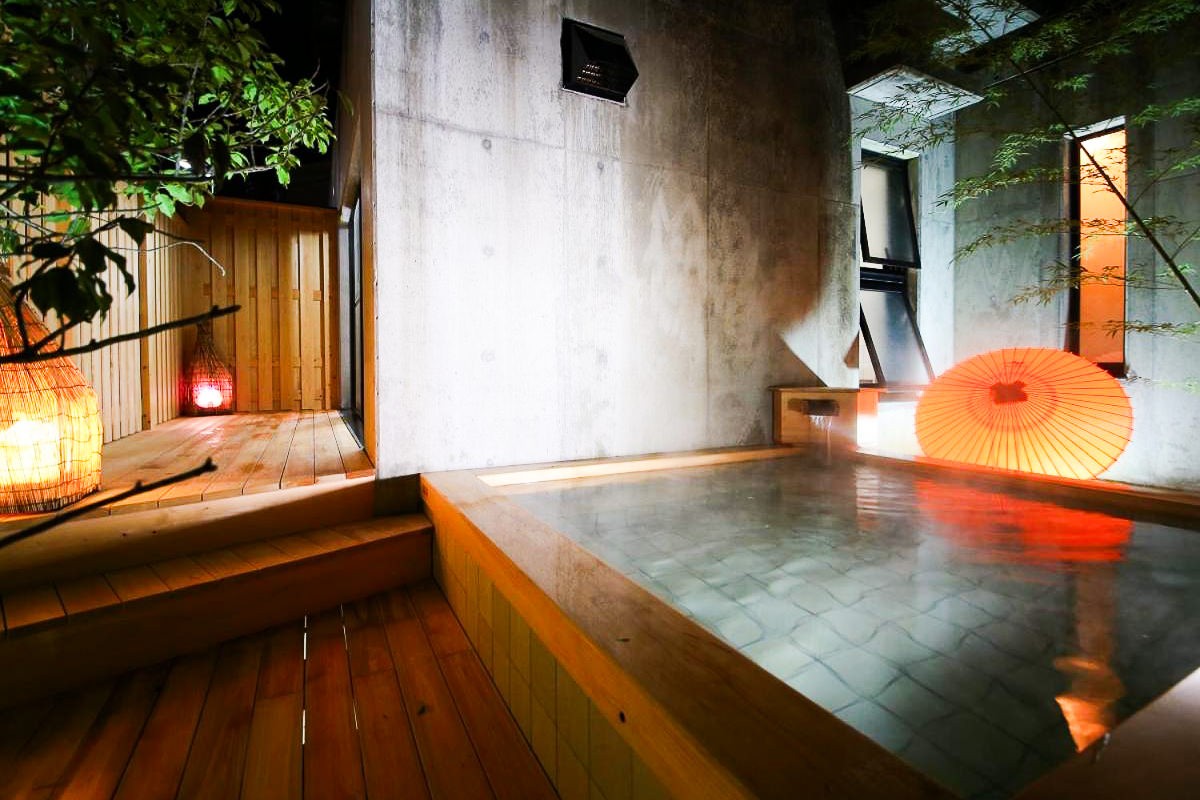
Kamei No Yu. Another spot that had a bath that really jumped out to me. Prices lower than Yorozuya, but it was priced for two people, so I went with Suminoyu.
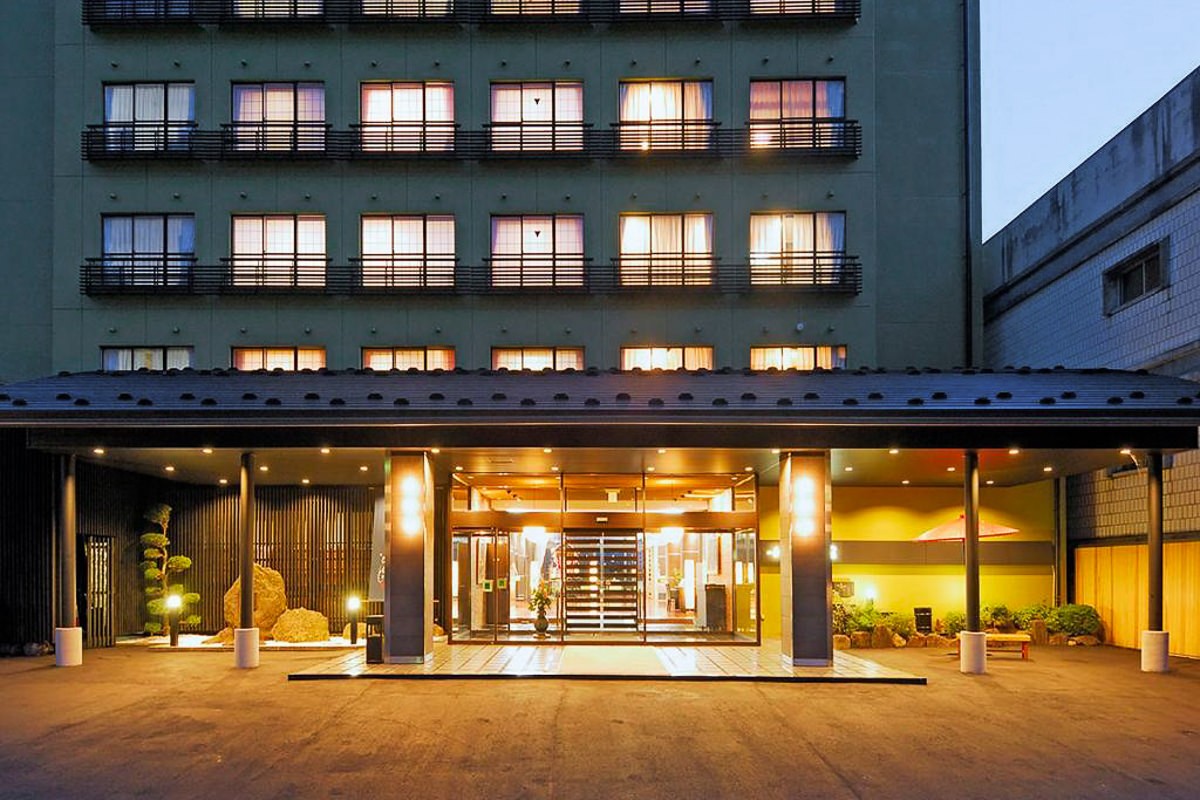
Ryokan Biyunoyado. This place has an amazing looking rooftop onsen and the meals looked amazing. They also have private onsens that you can reserve for you and your partner.
Can You Bathe With The Japanese Snow Monkeys?
The original Korakukan hotel where the monkeys first started bathing is still there. They offer overnight stays right in Jigokudani Valley with 5 different baths for guests. There is also the famous mixed-gender outdoor bath where the monkeys still pop in from time to time. They may or may not get in with you, but it’s the only place I know of where you can bathe in a beautiful outdoor stone pool with monkeys around you.
They also offer day passes for ¥1200, where you can soak in the hot springs from 12:00 pm to 4 pm. It’s an ideal time for a soak in nature after your visit to the Jigokudani Monkey Park. The interior is very rustic and is what you would expect from an authentic traditional bathhouse and ryokan.
If you haven’t already, go put this experience on your radar. If you’re looking for more travel inspirations, scroll through some of the 450+ experiences on my bucket list. Maybe you’ll find your next adventure on there.
How You Can Help
When you make a purchase using these links, you’ll help support this site at no cost to you.
| Booking.com | Agoda.com |
| Amazon.com | Klook.com |
| Viator.com | GetYourGuide.com |
Updated on June 6, 2024


